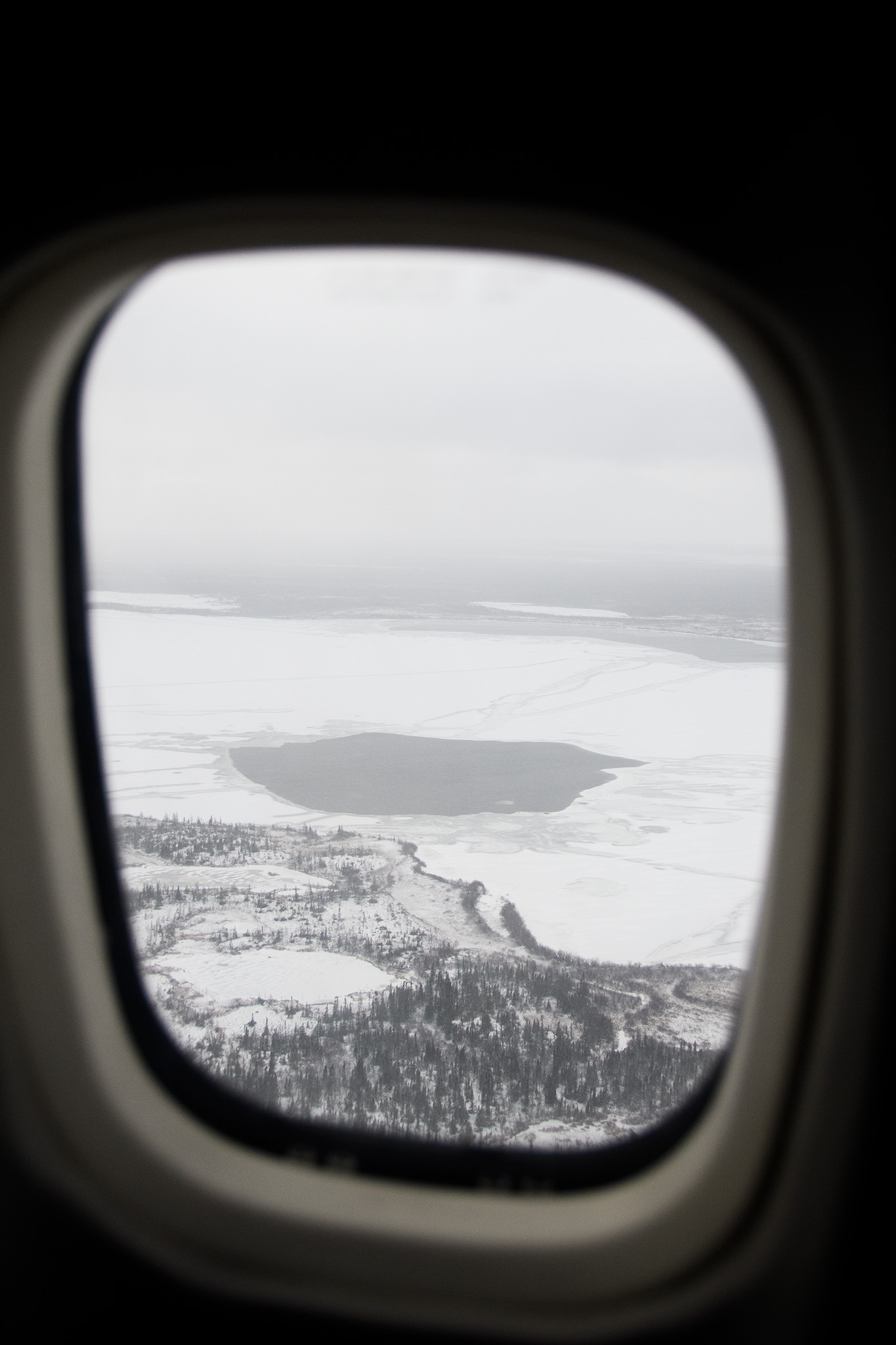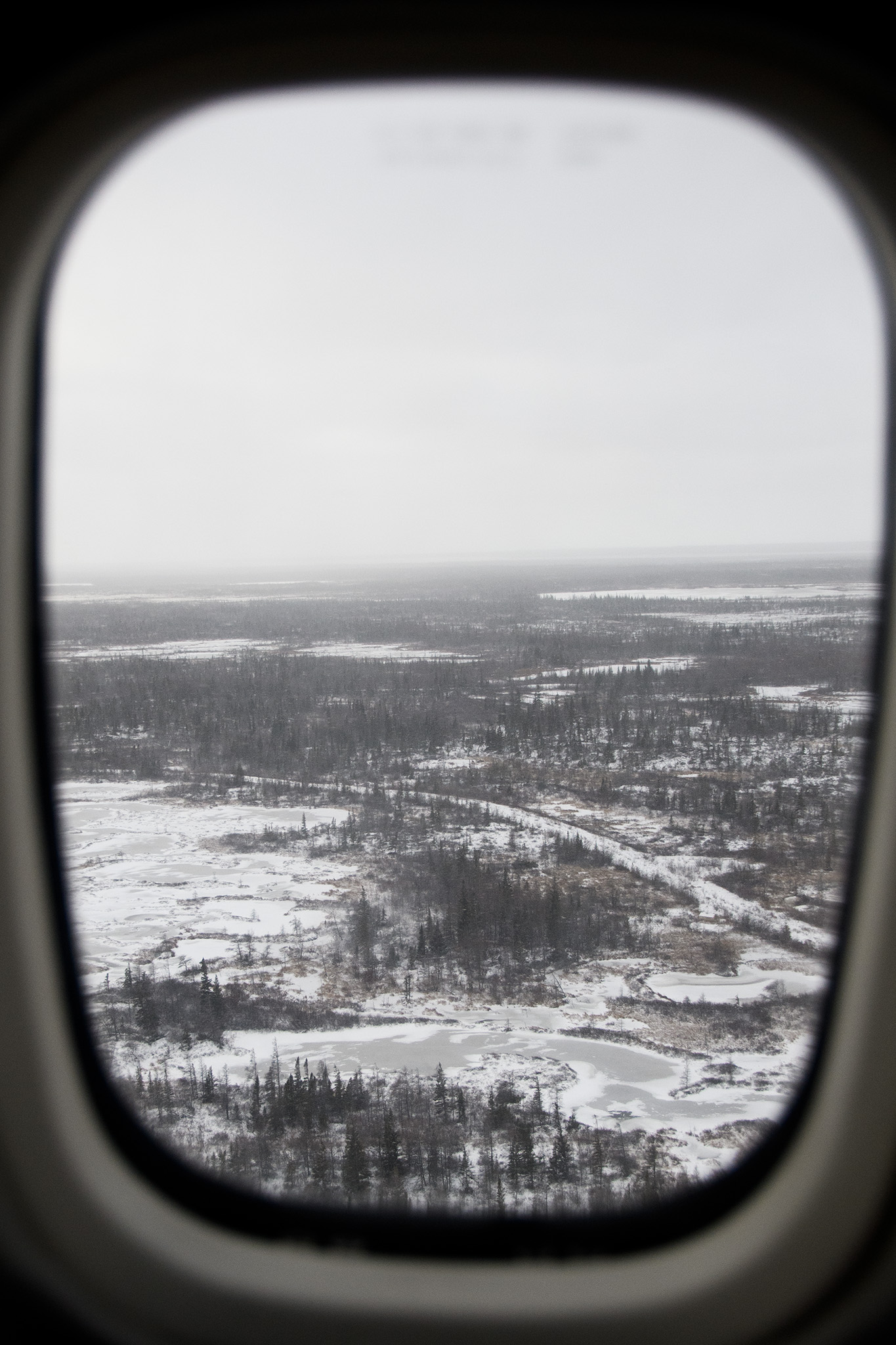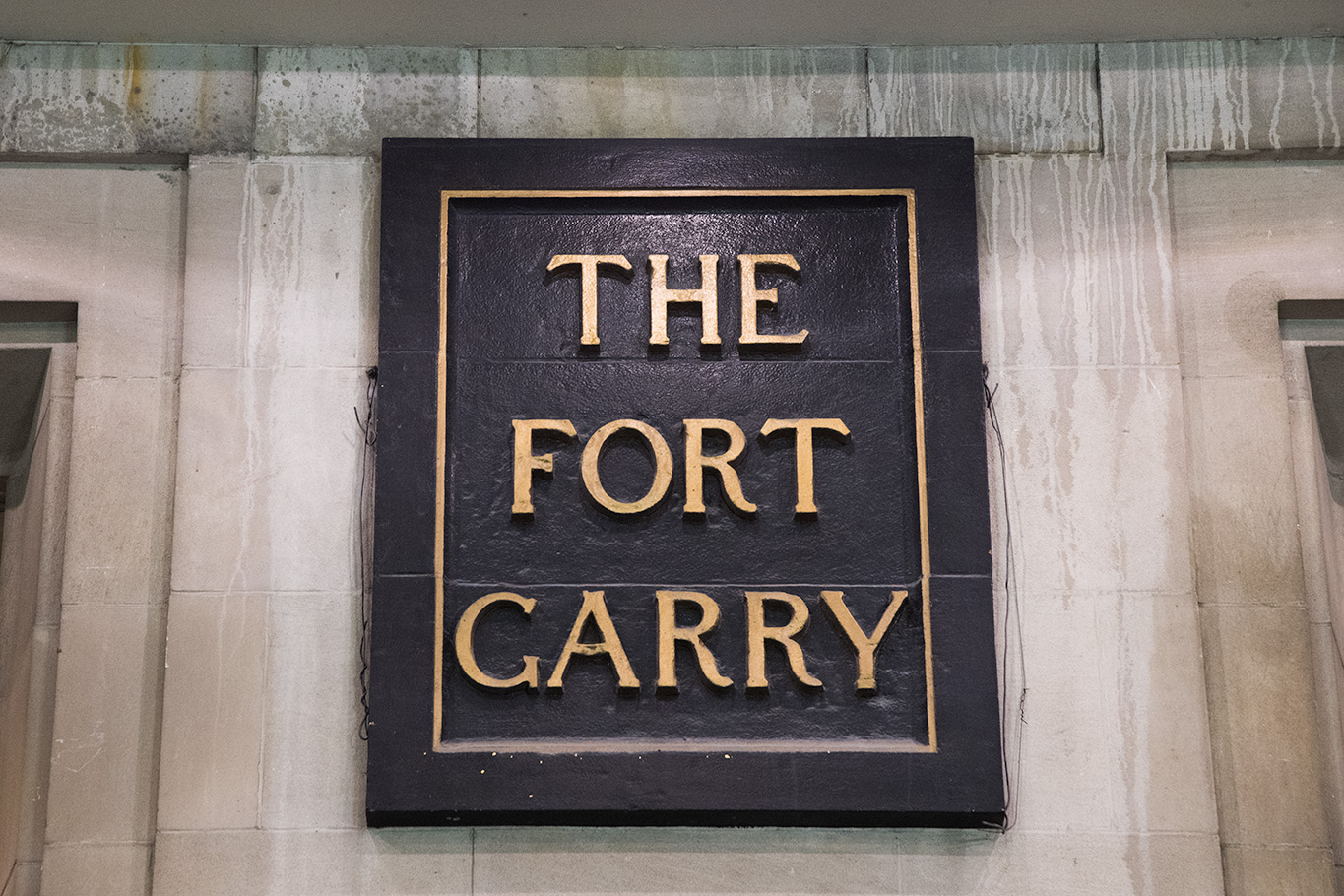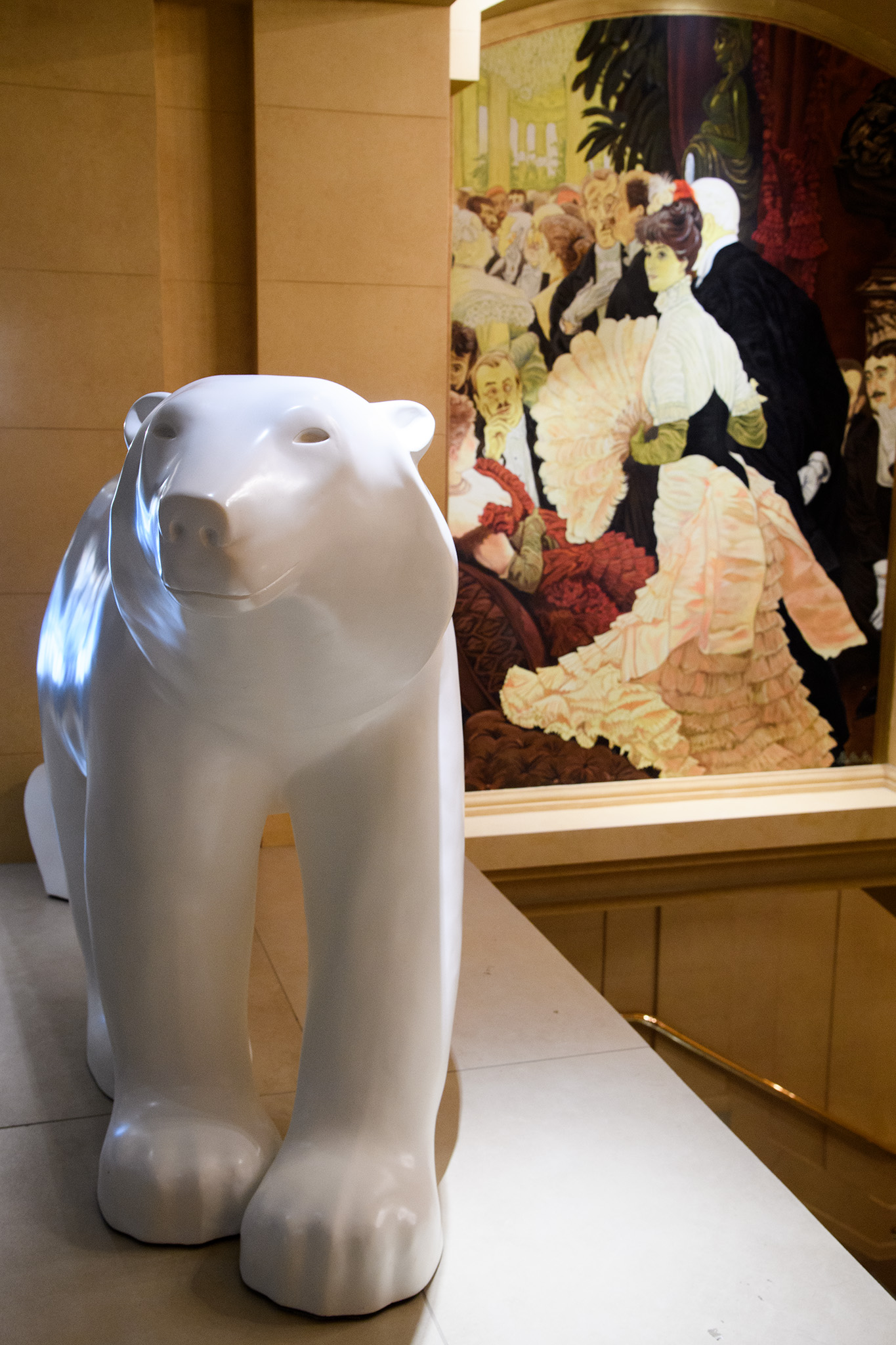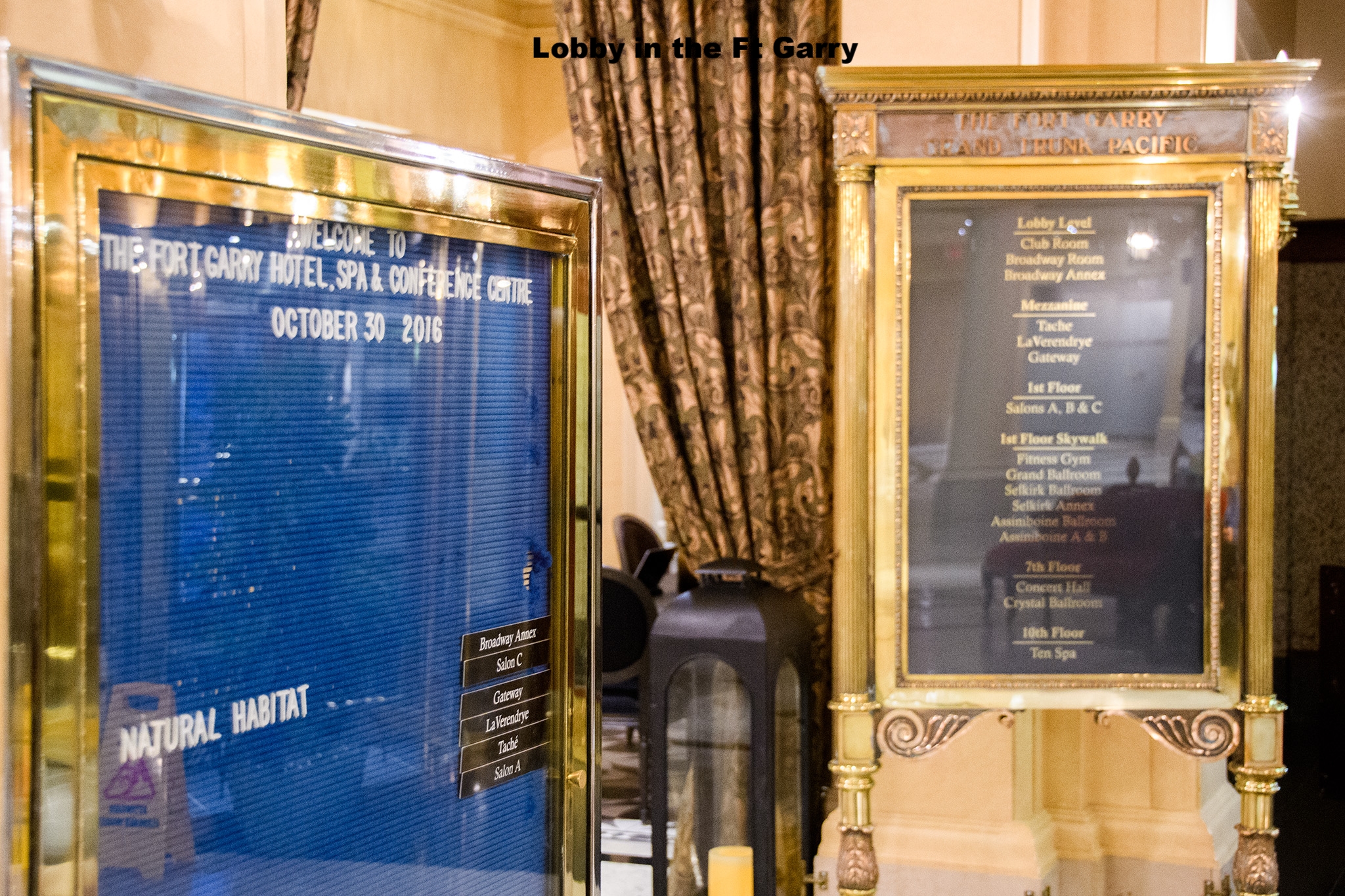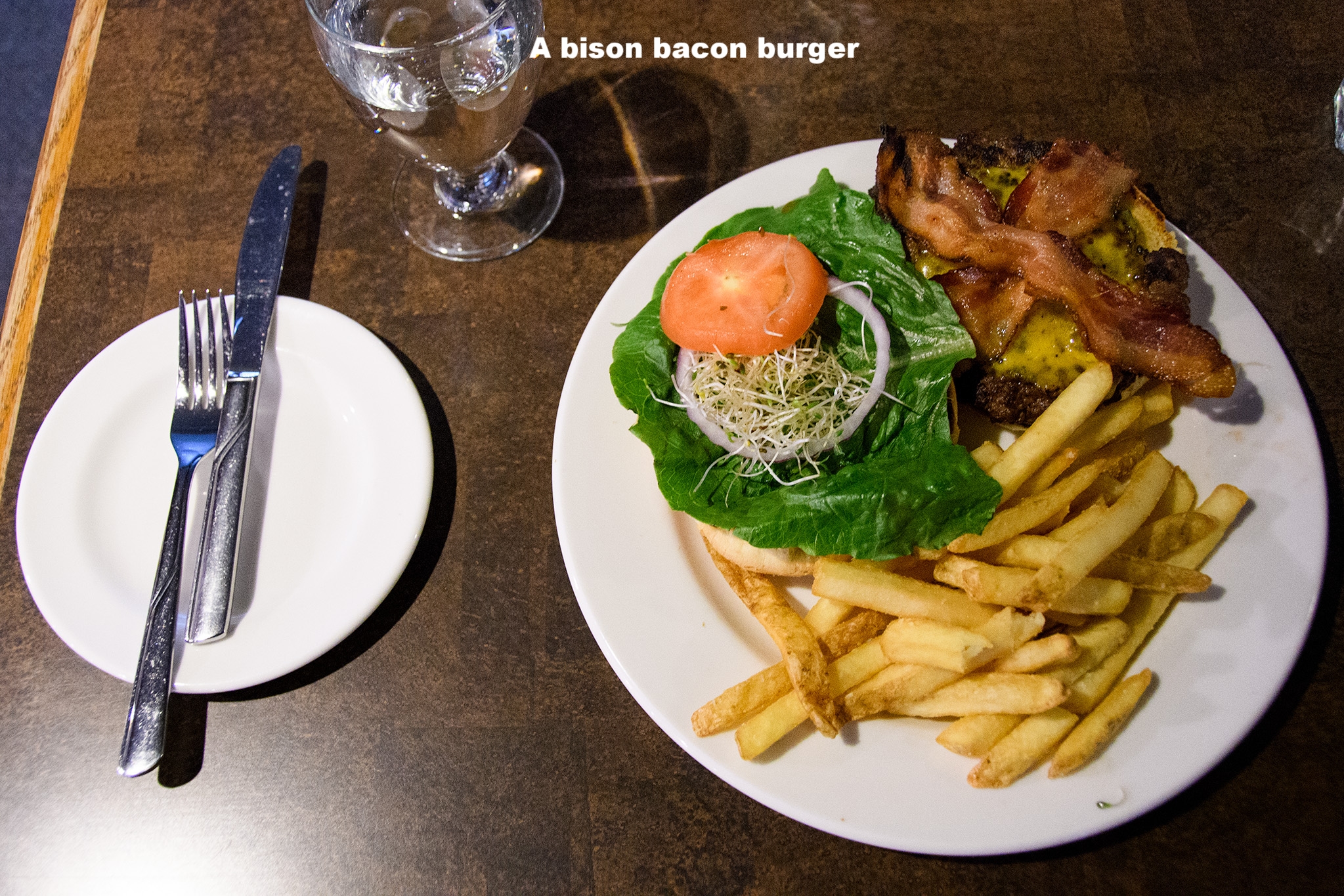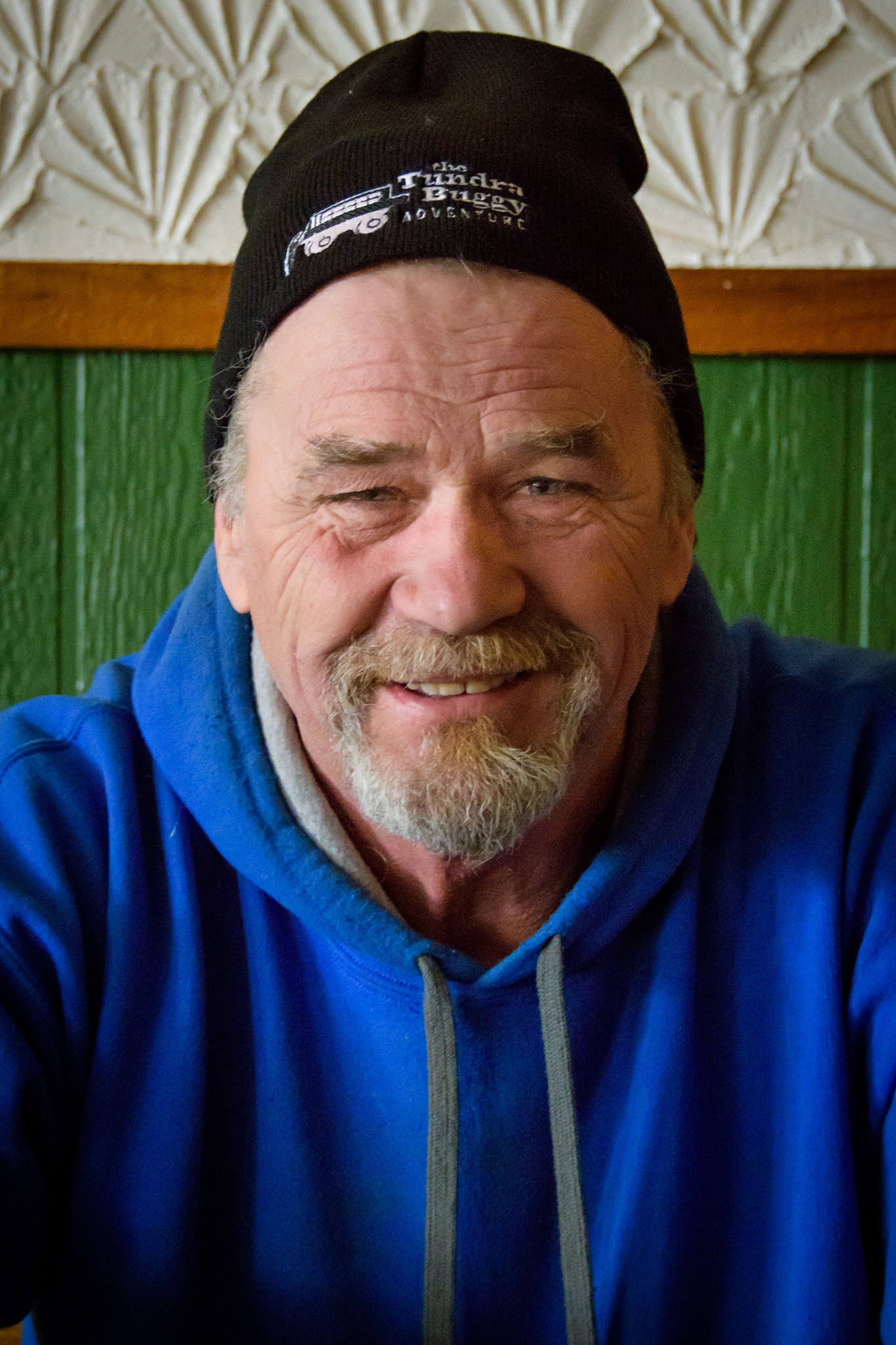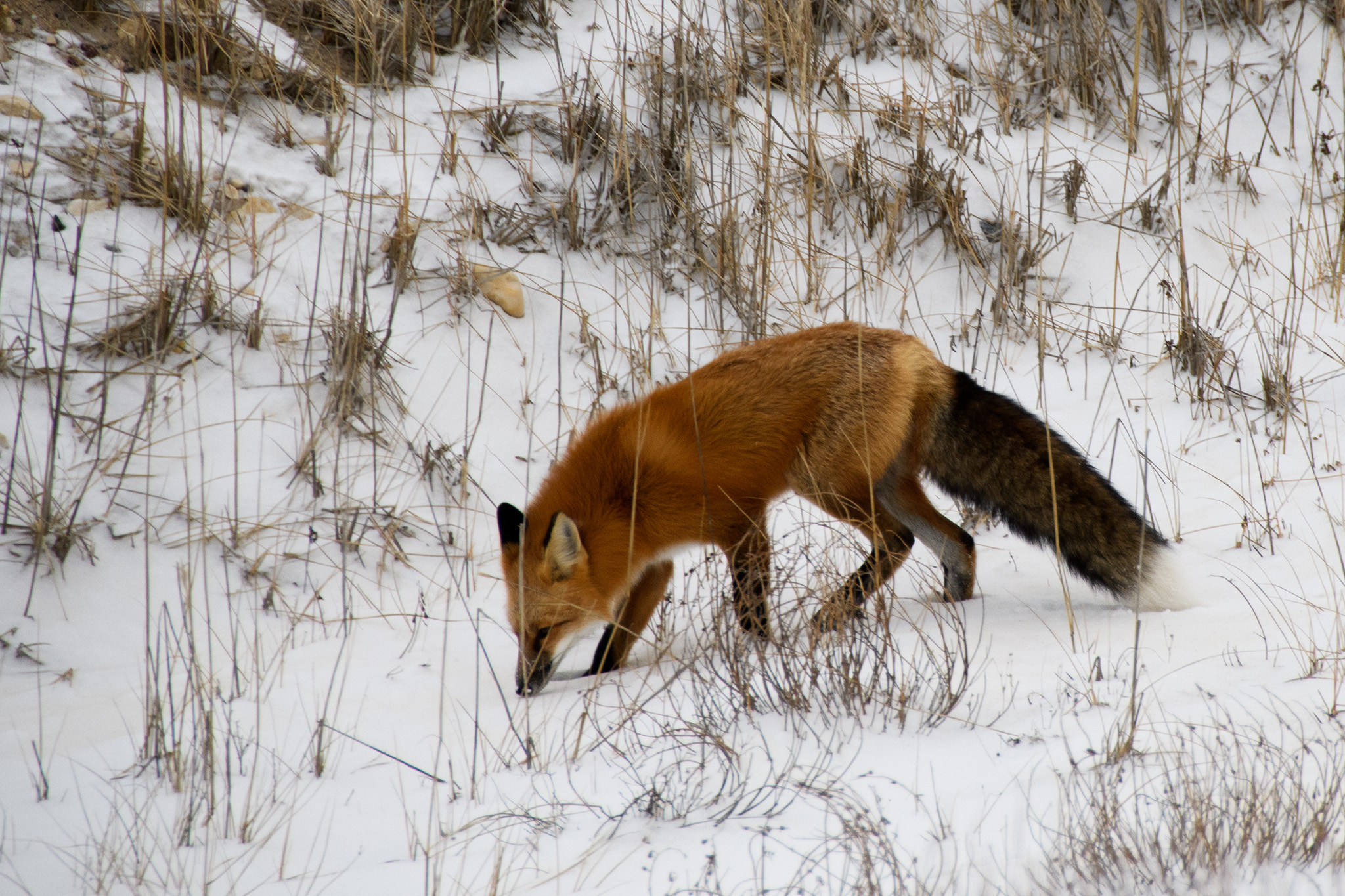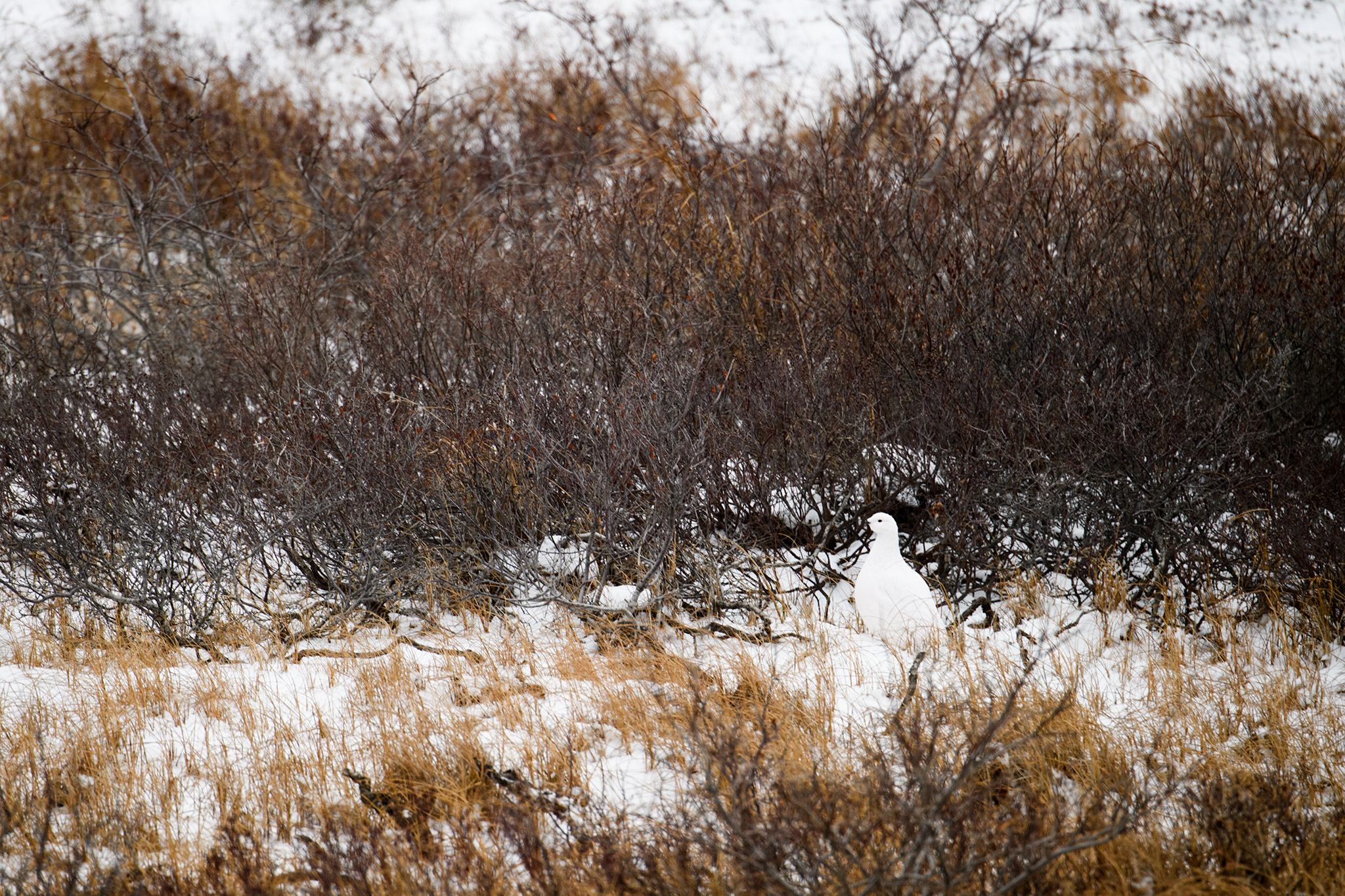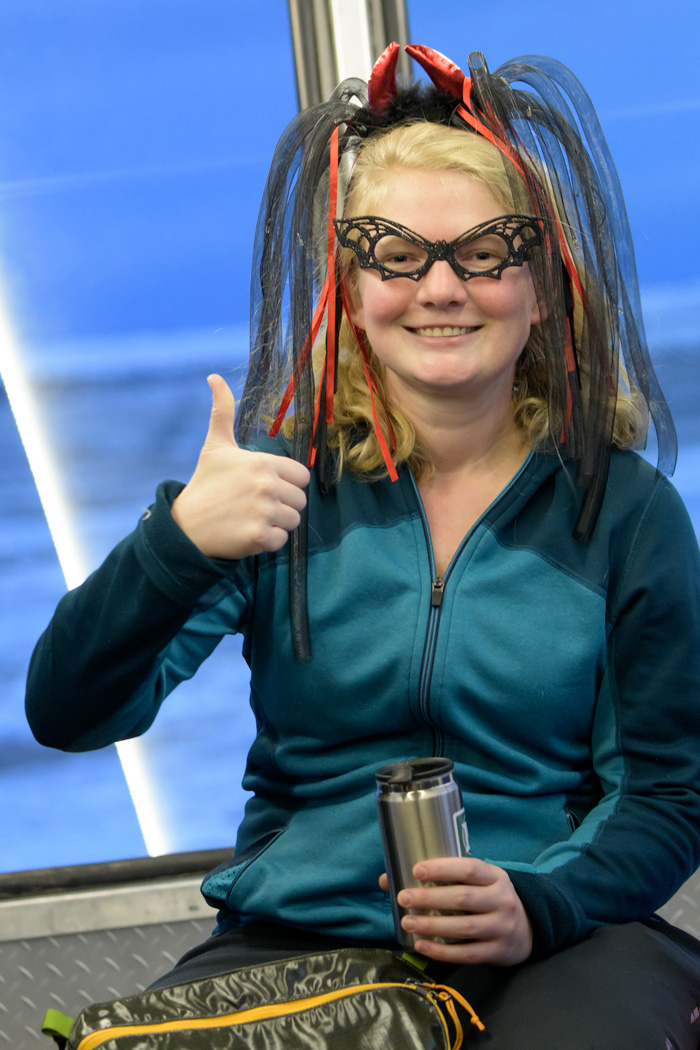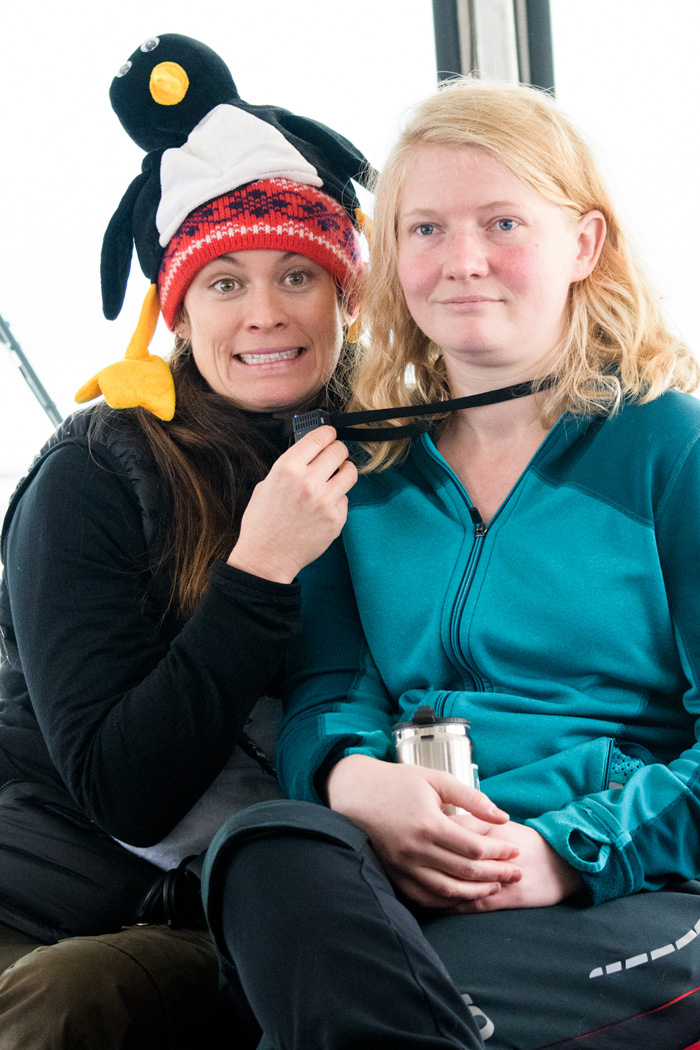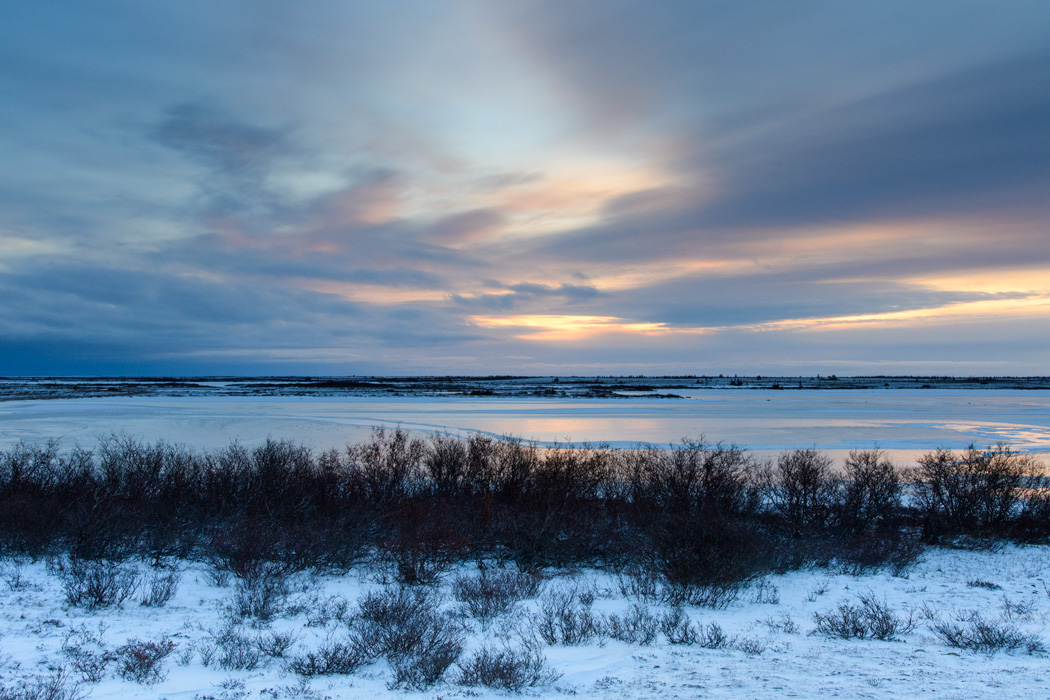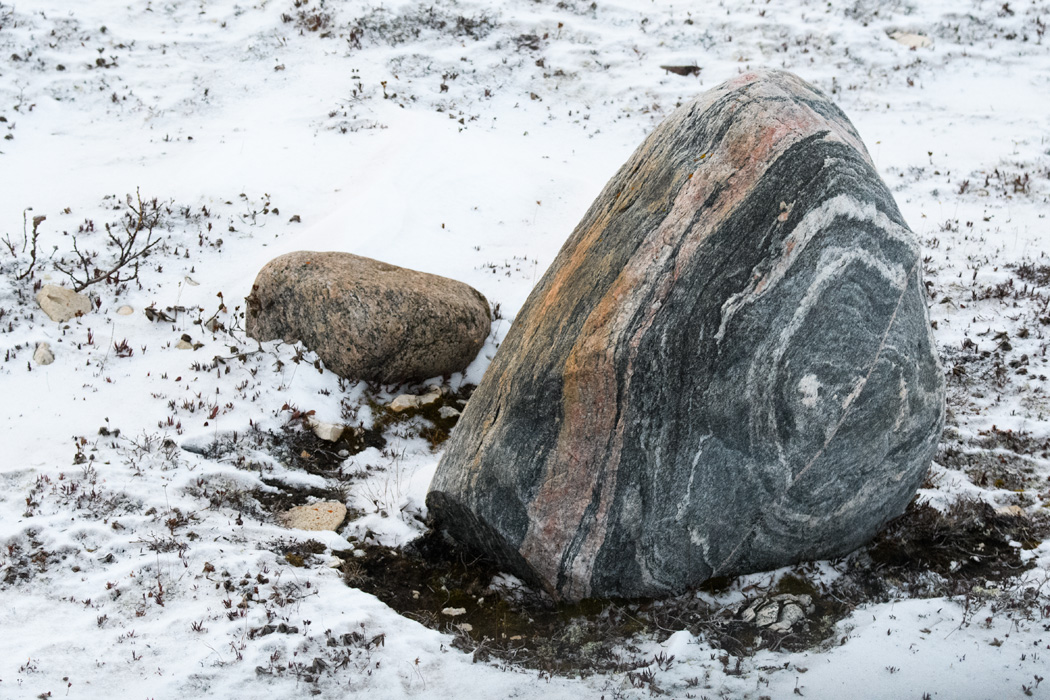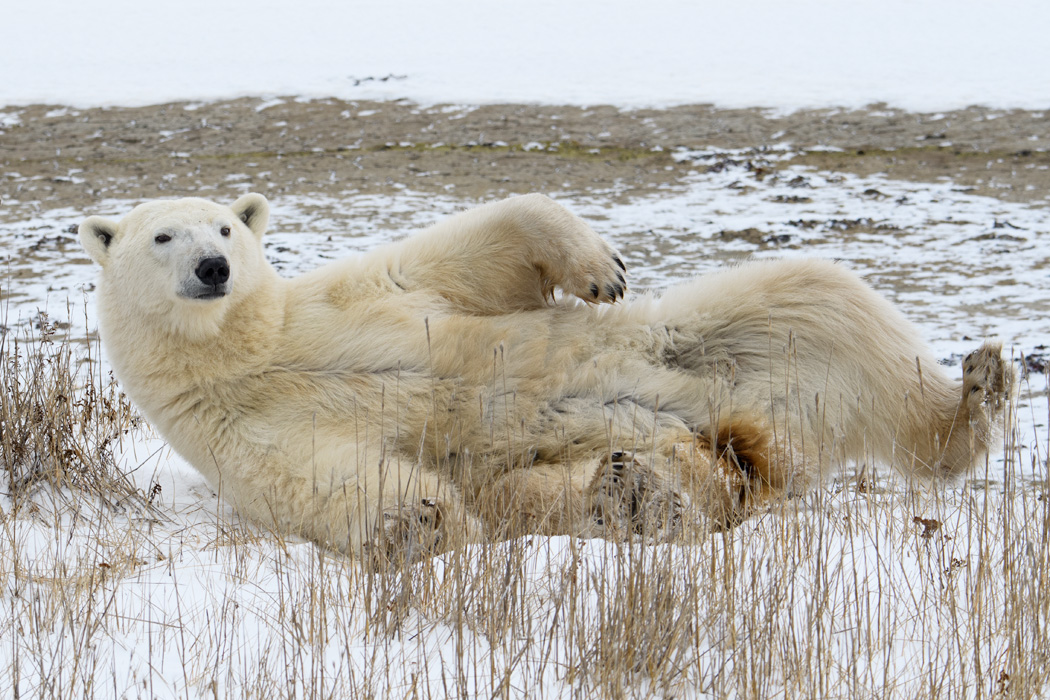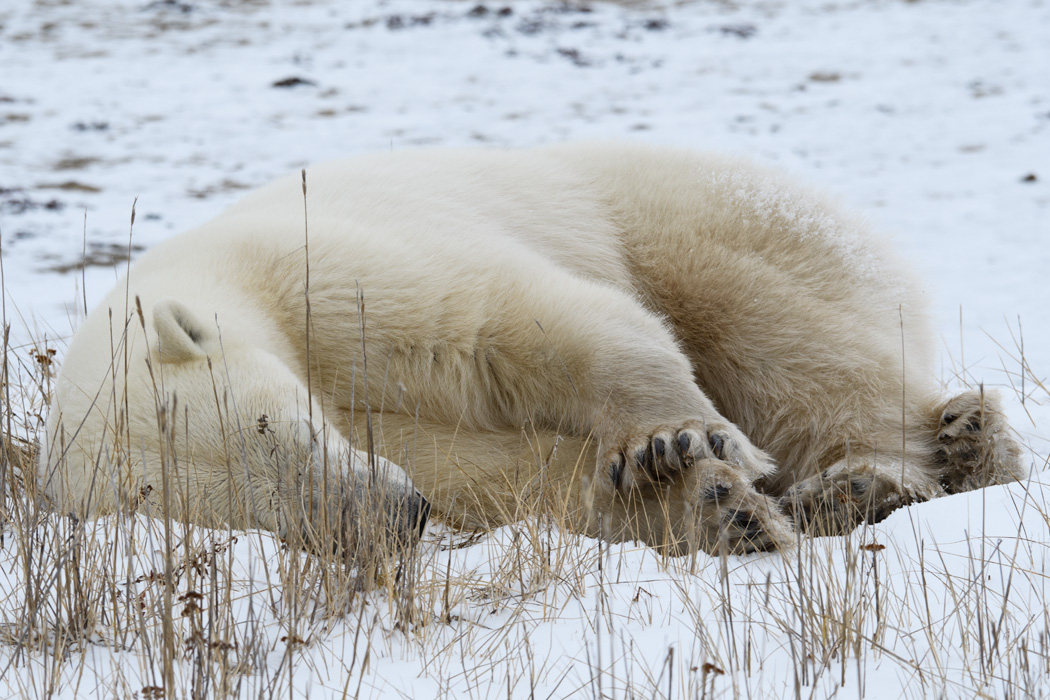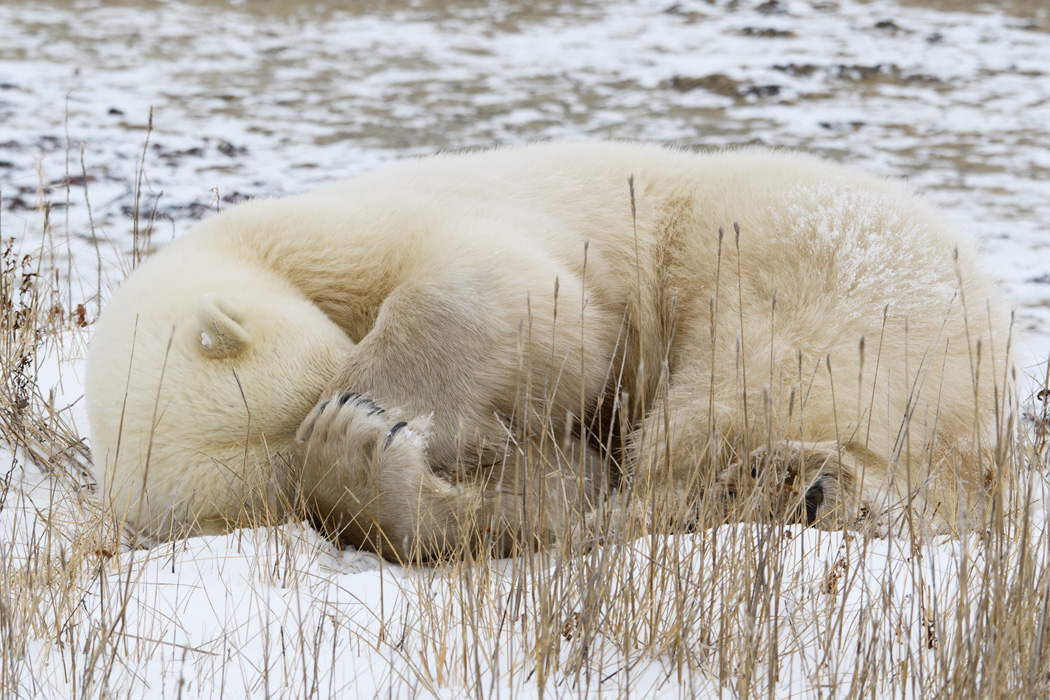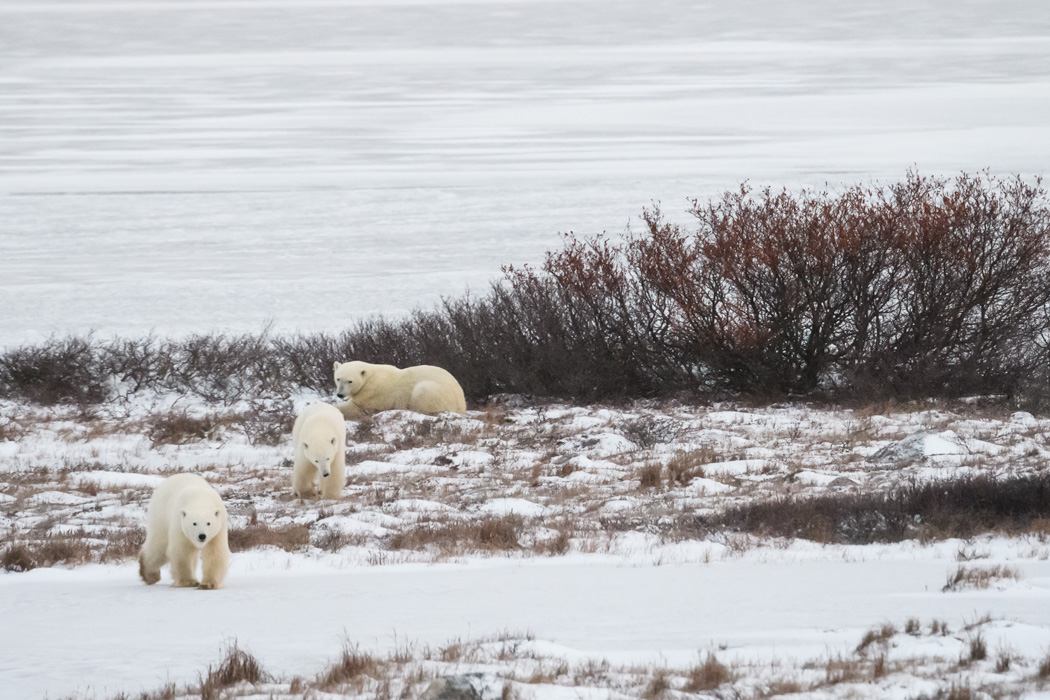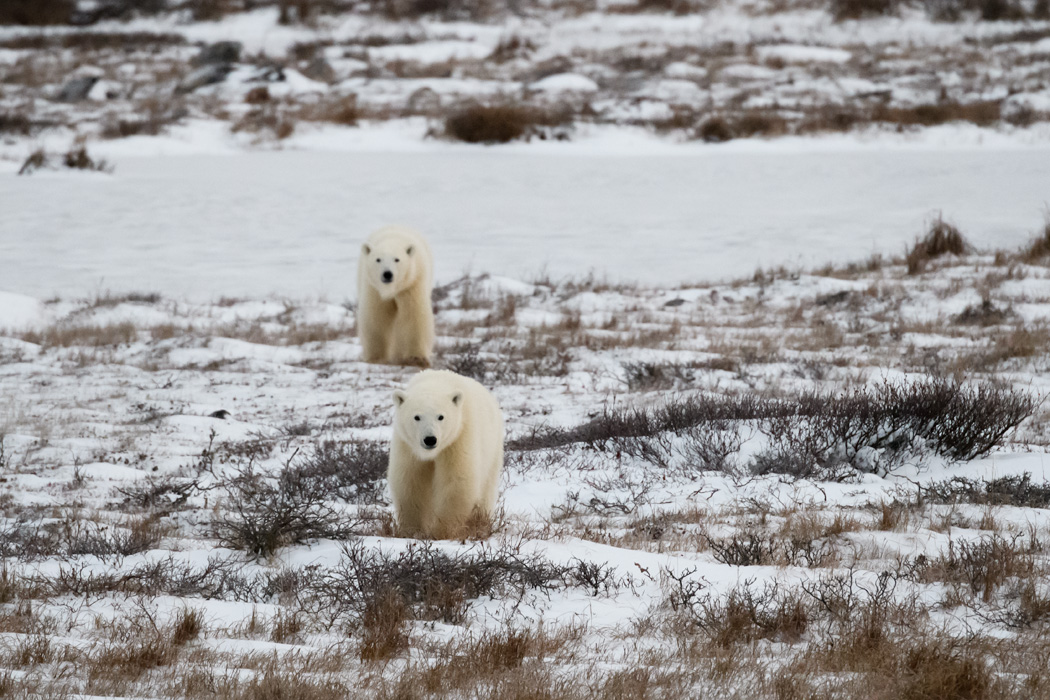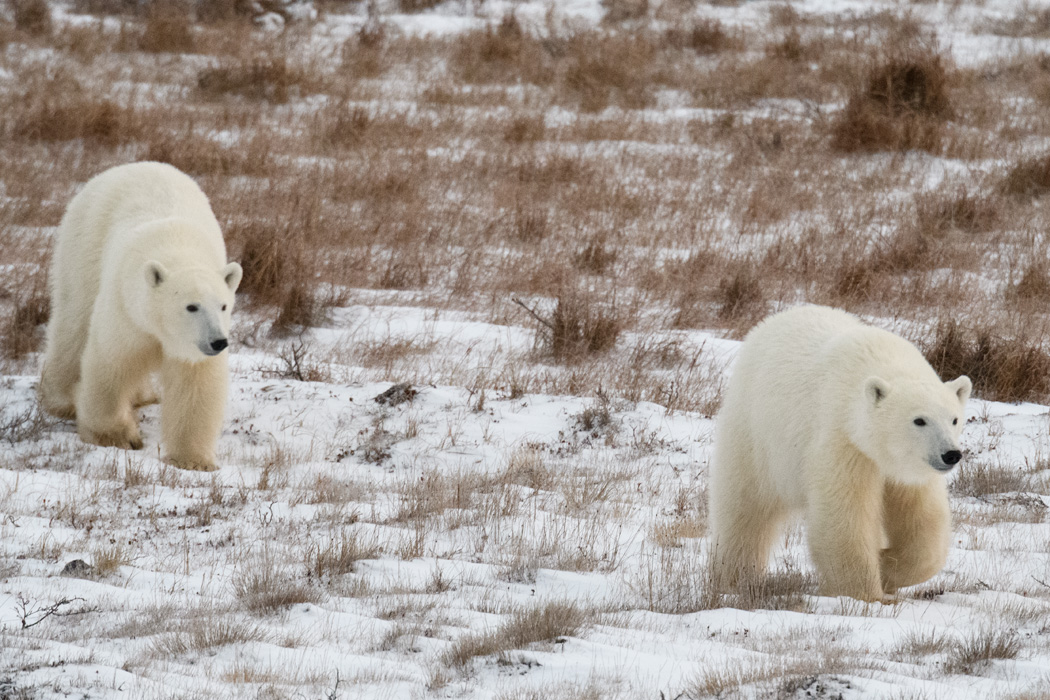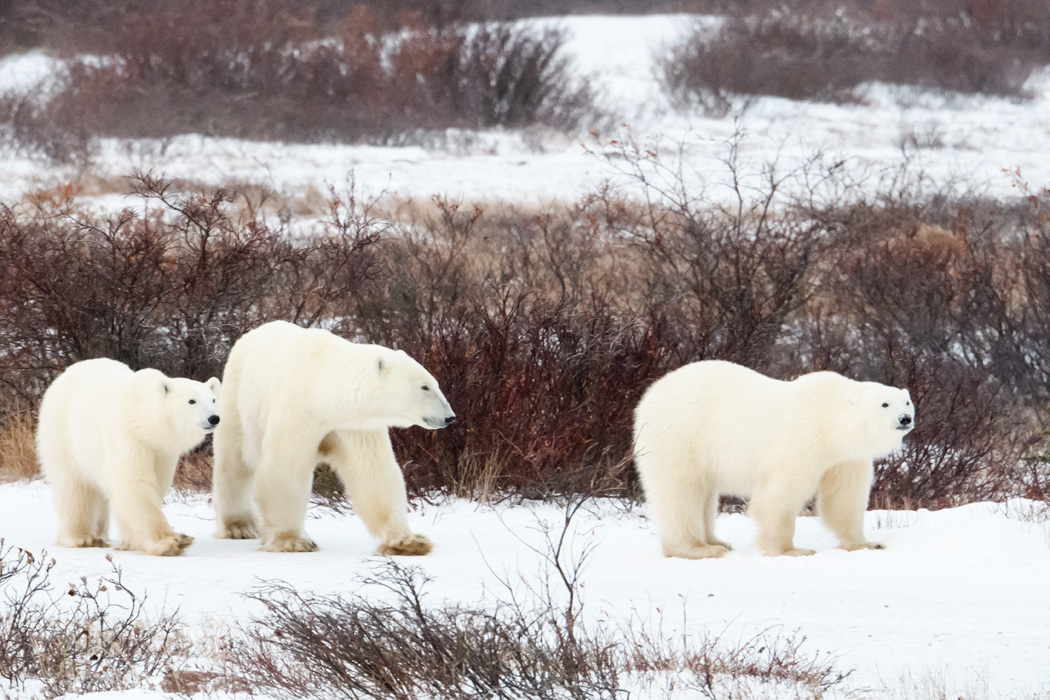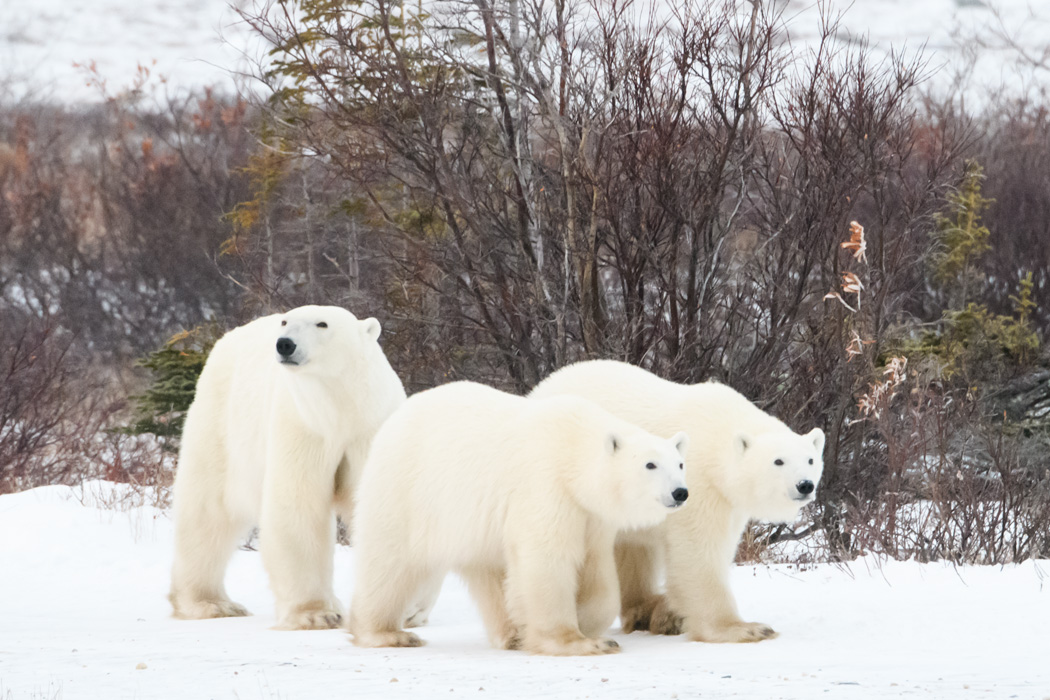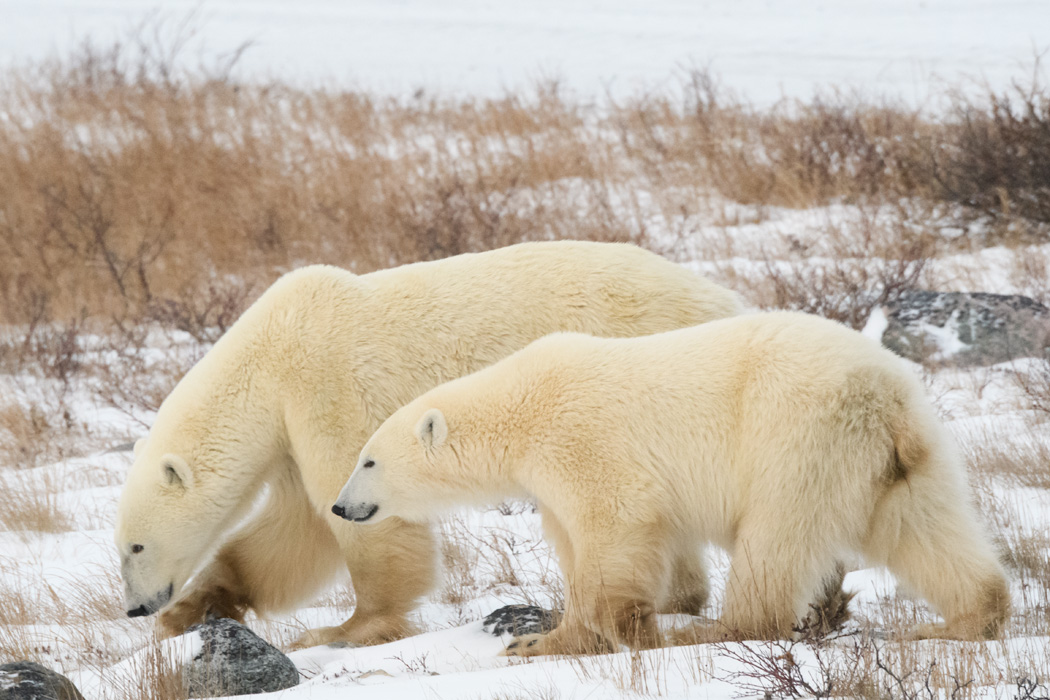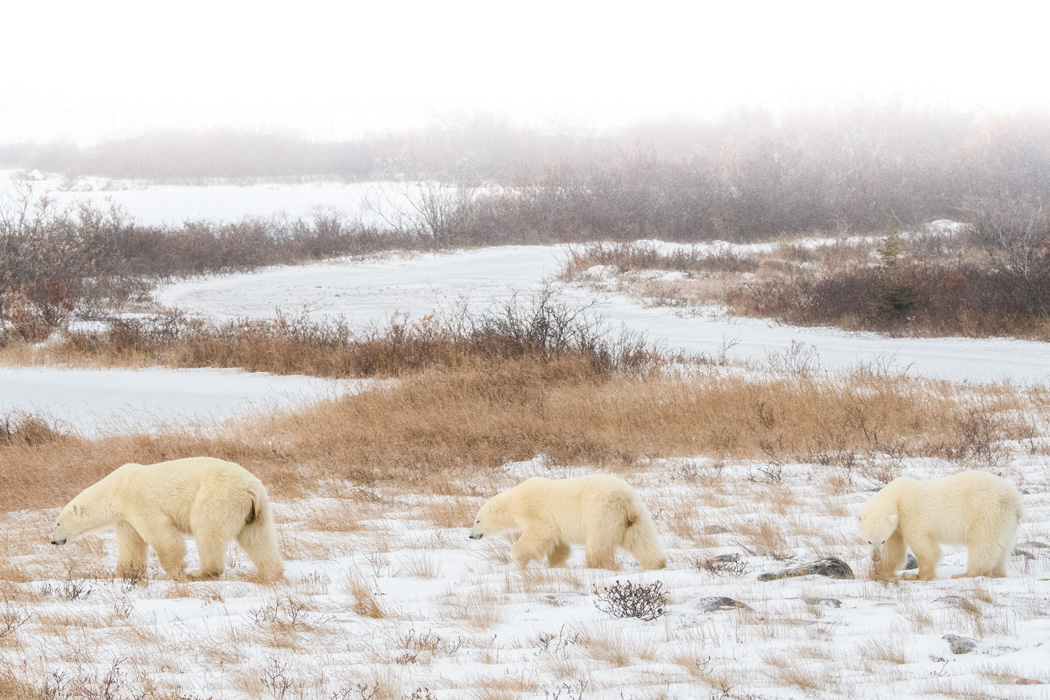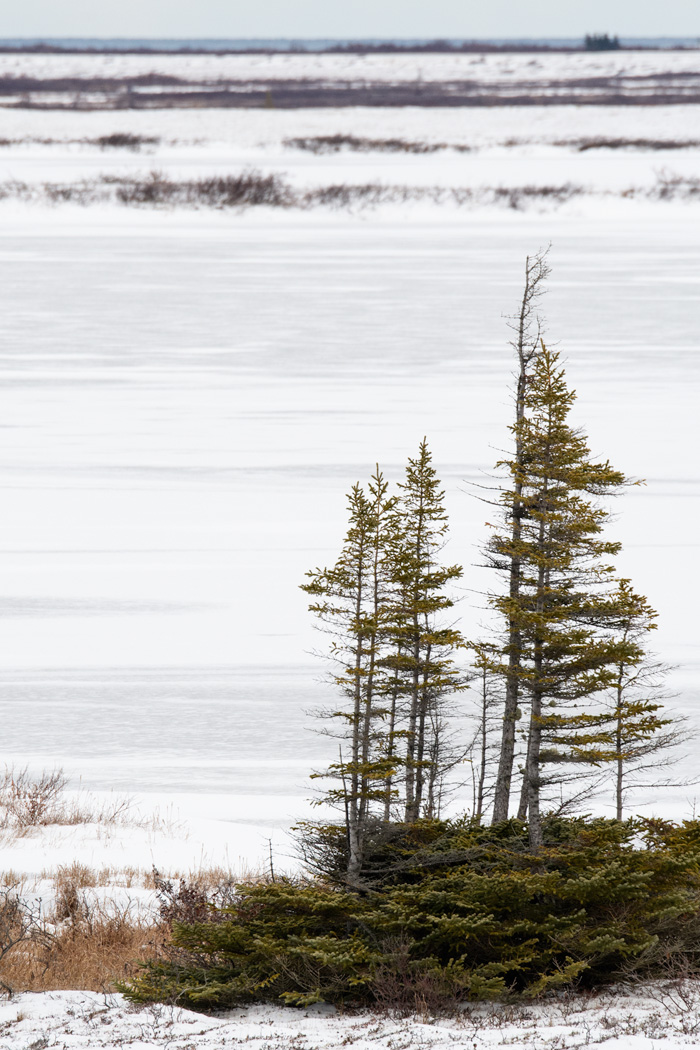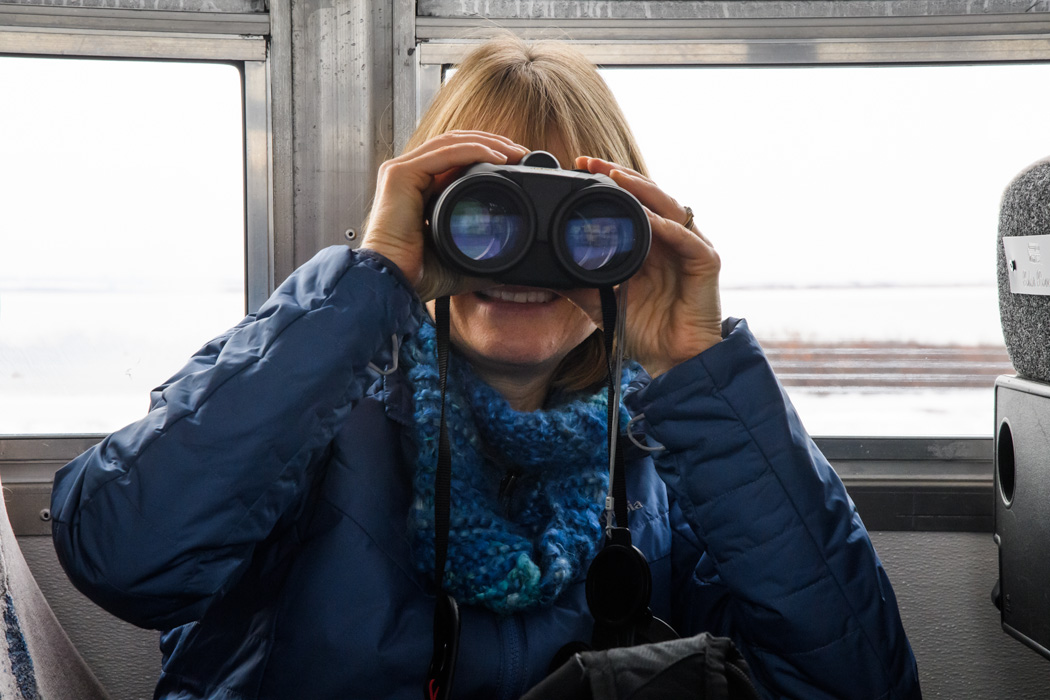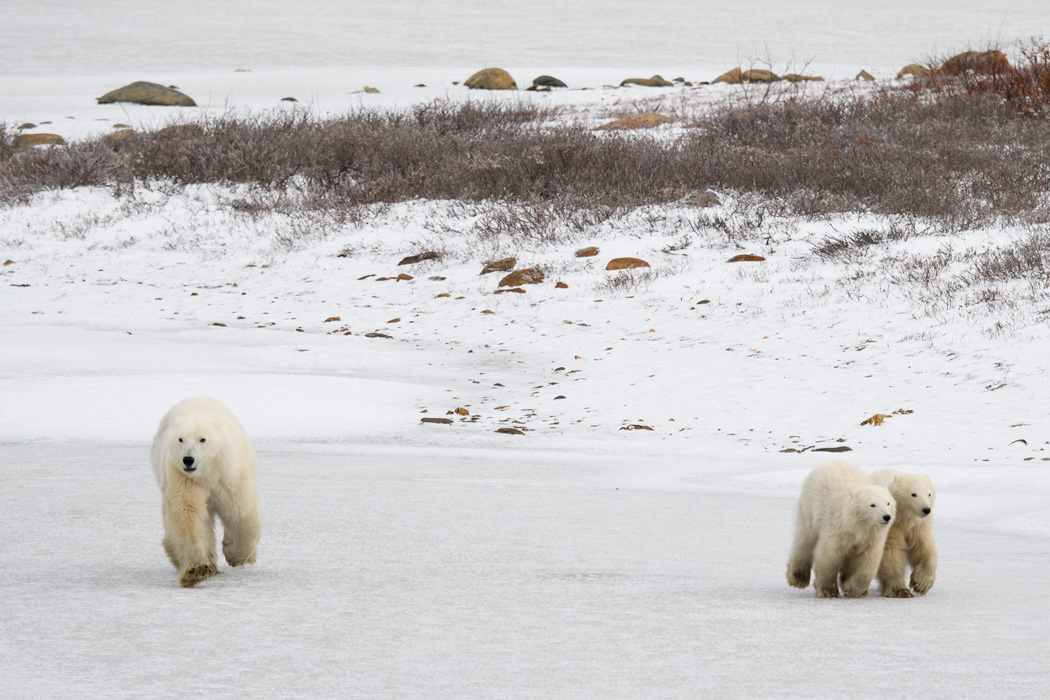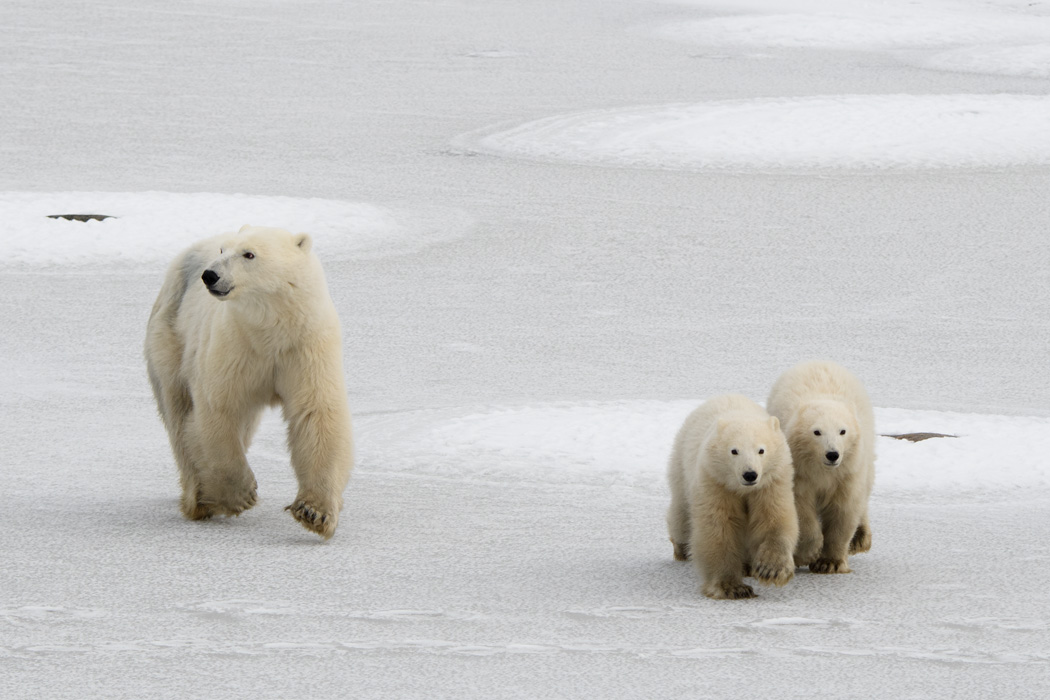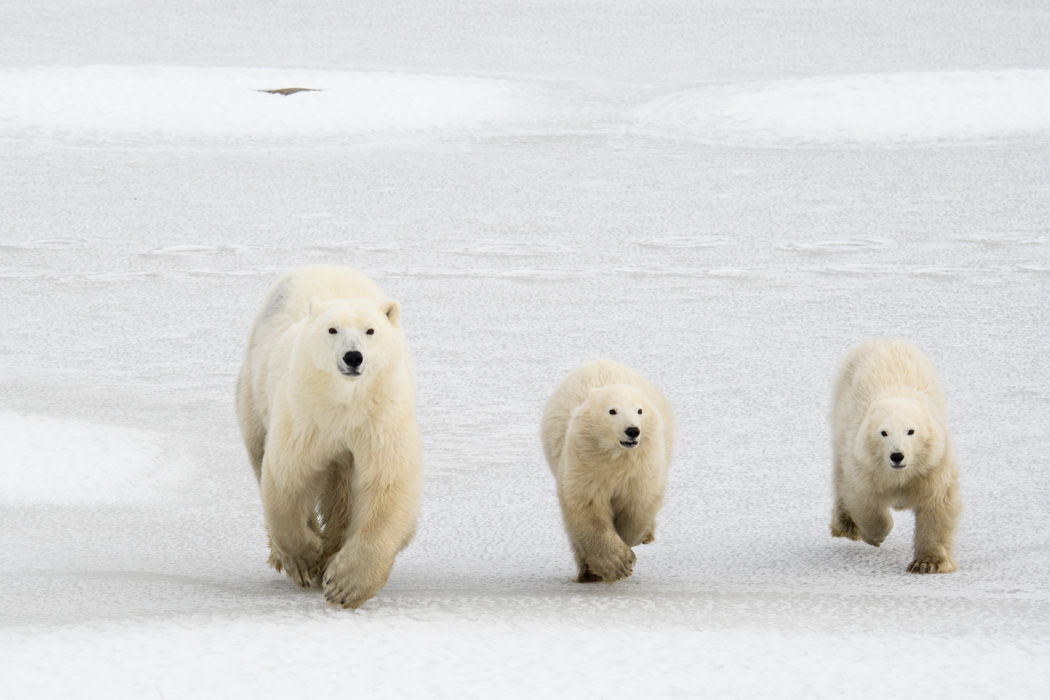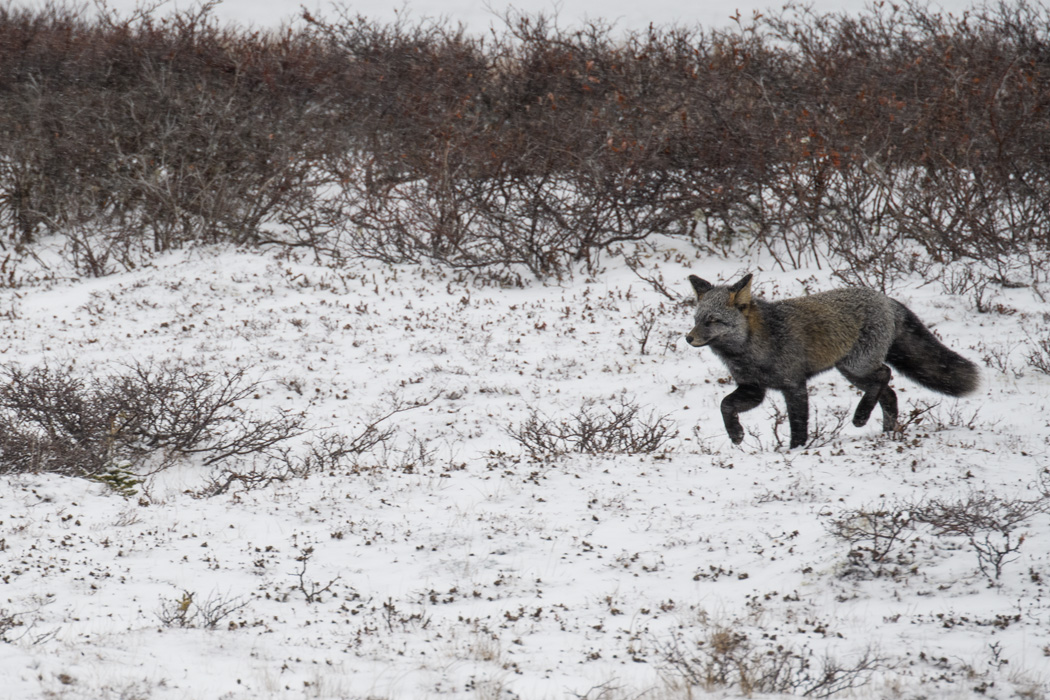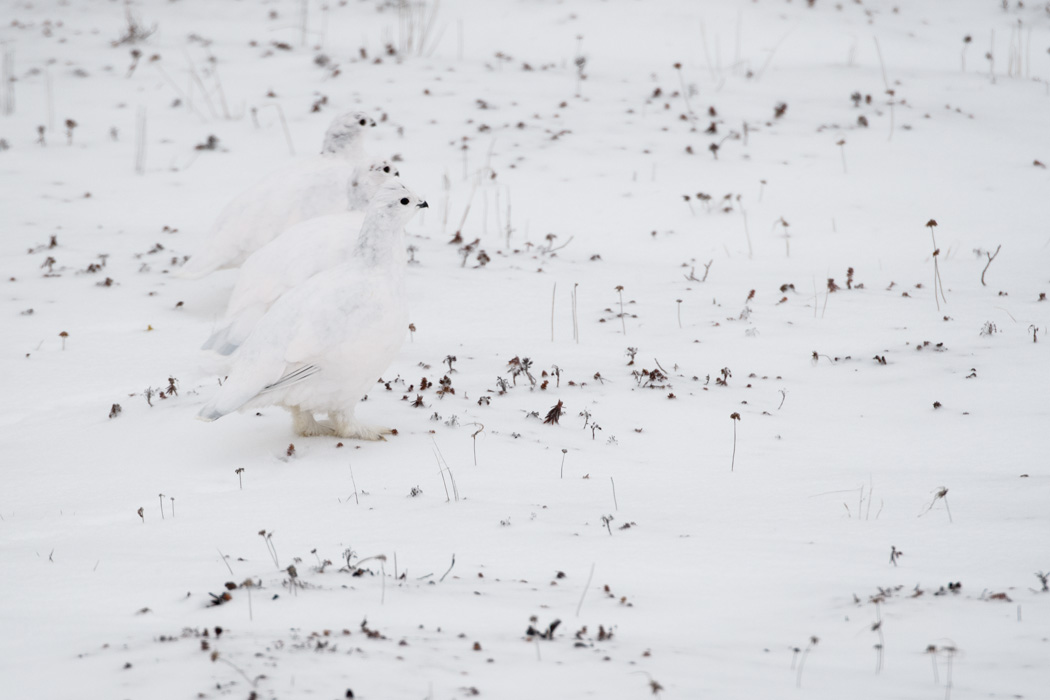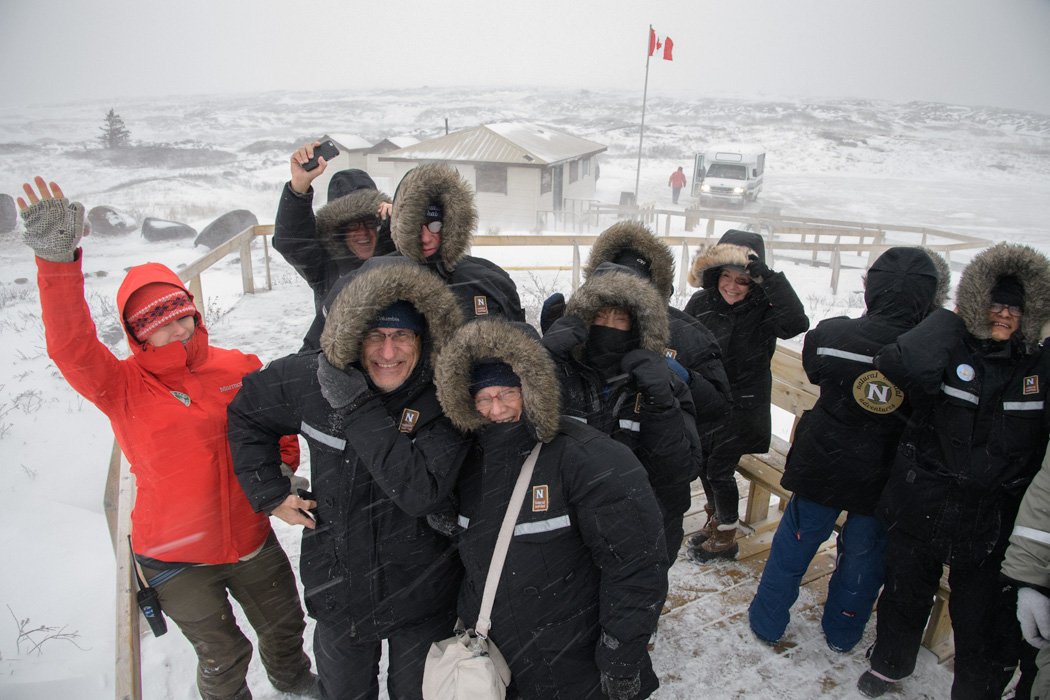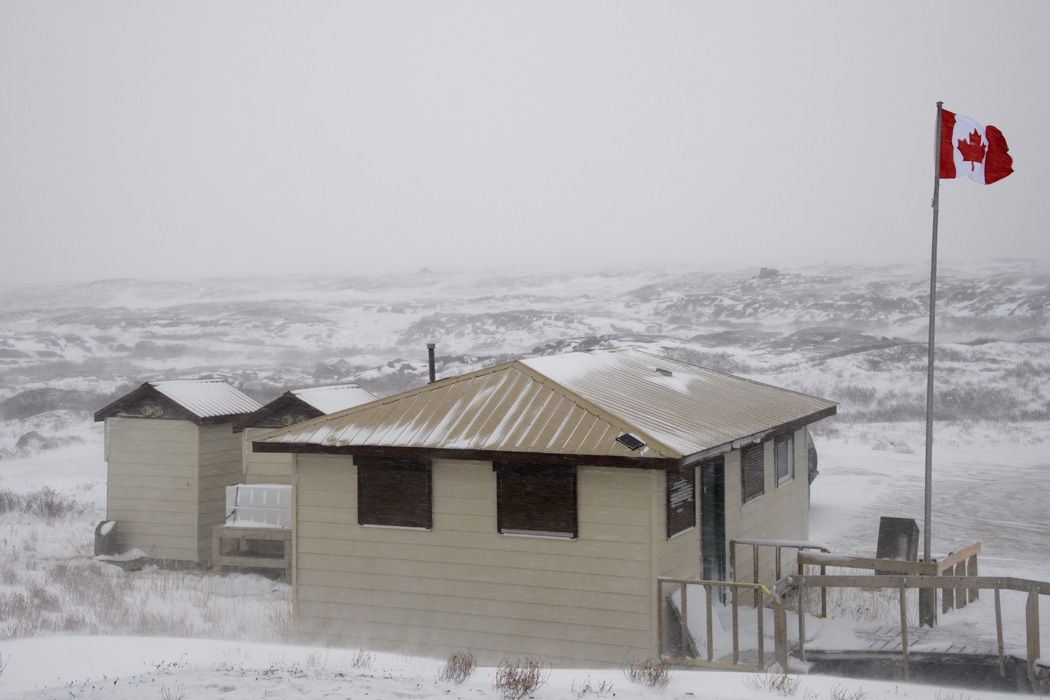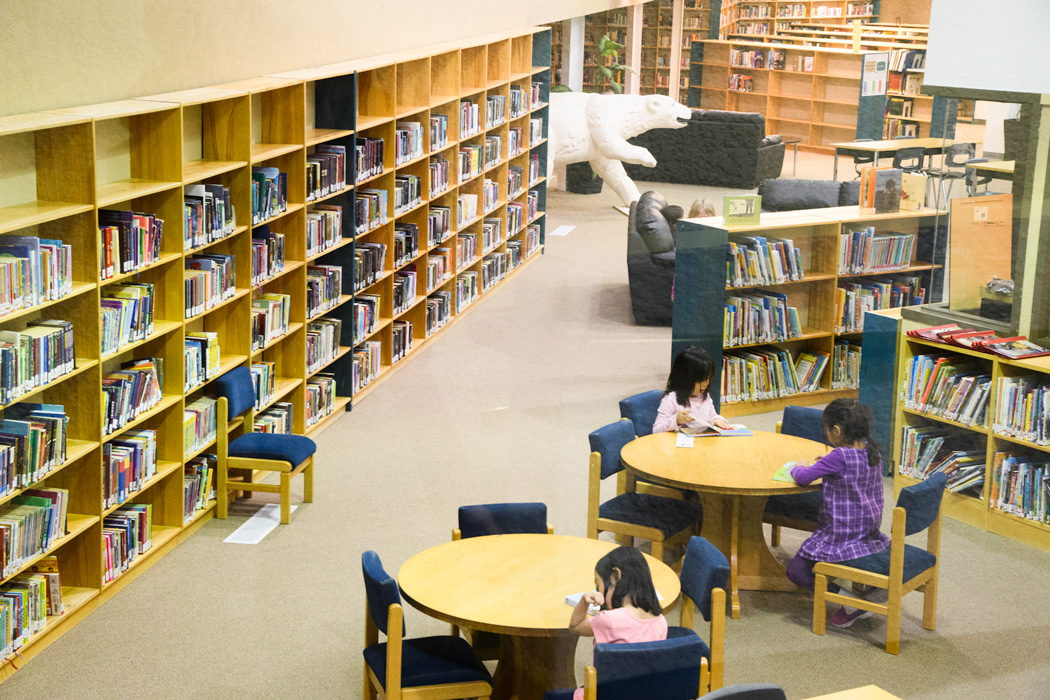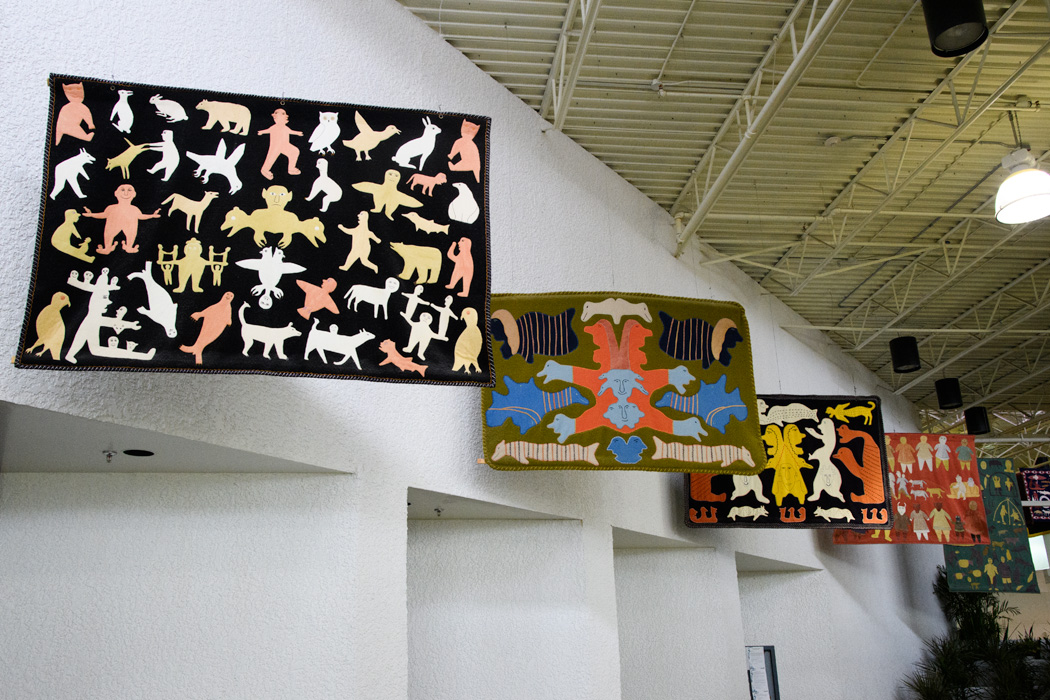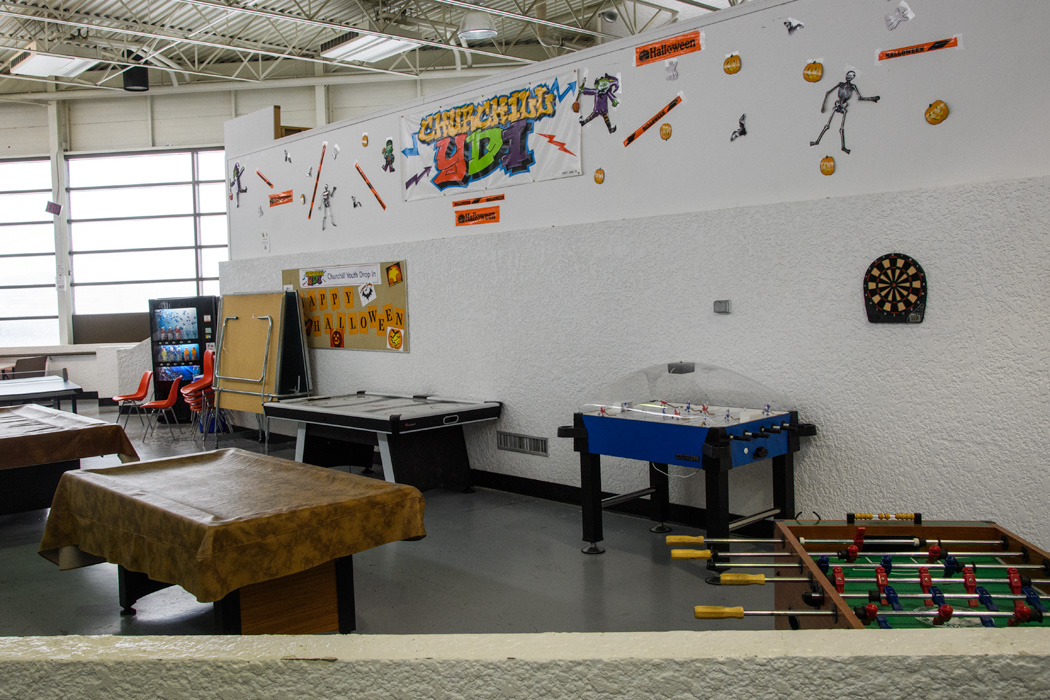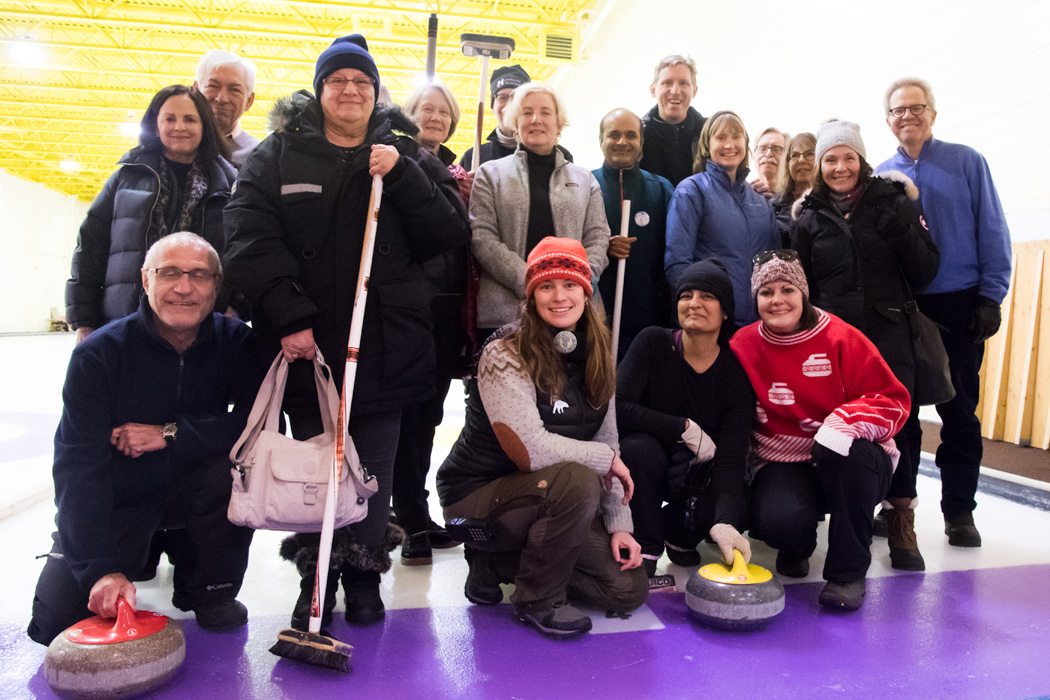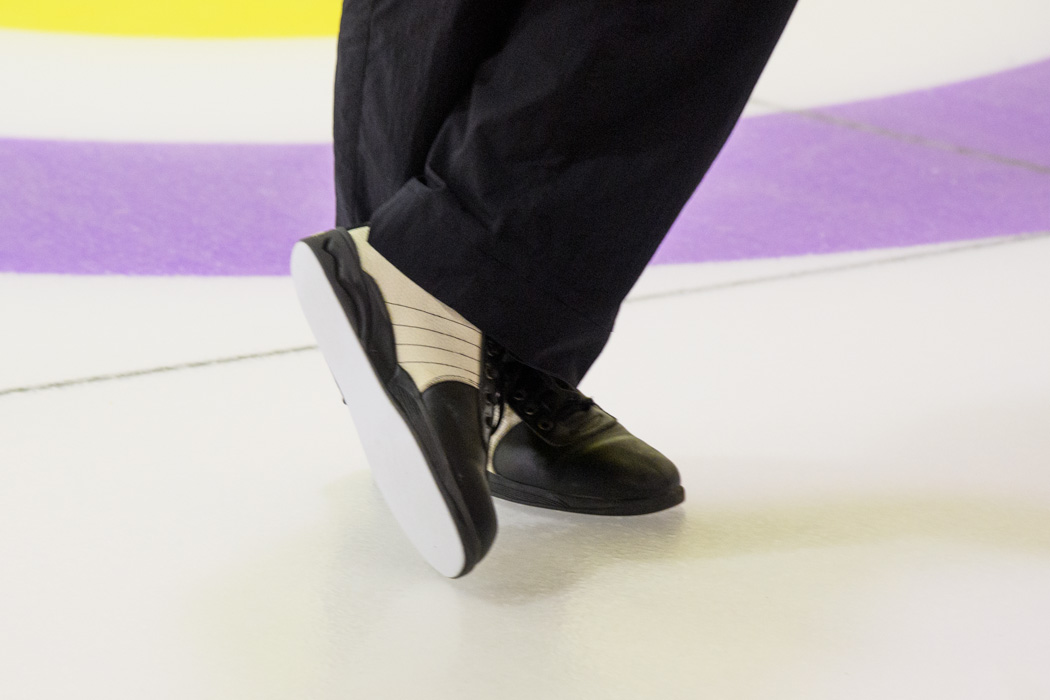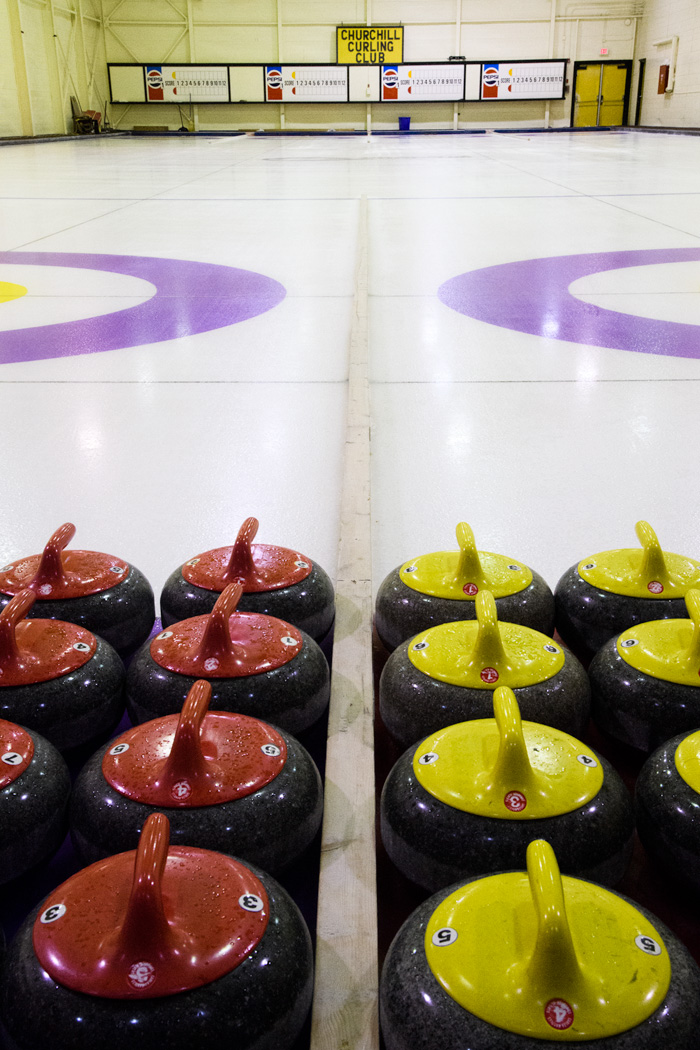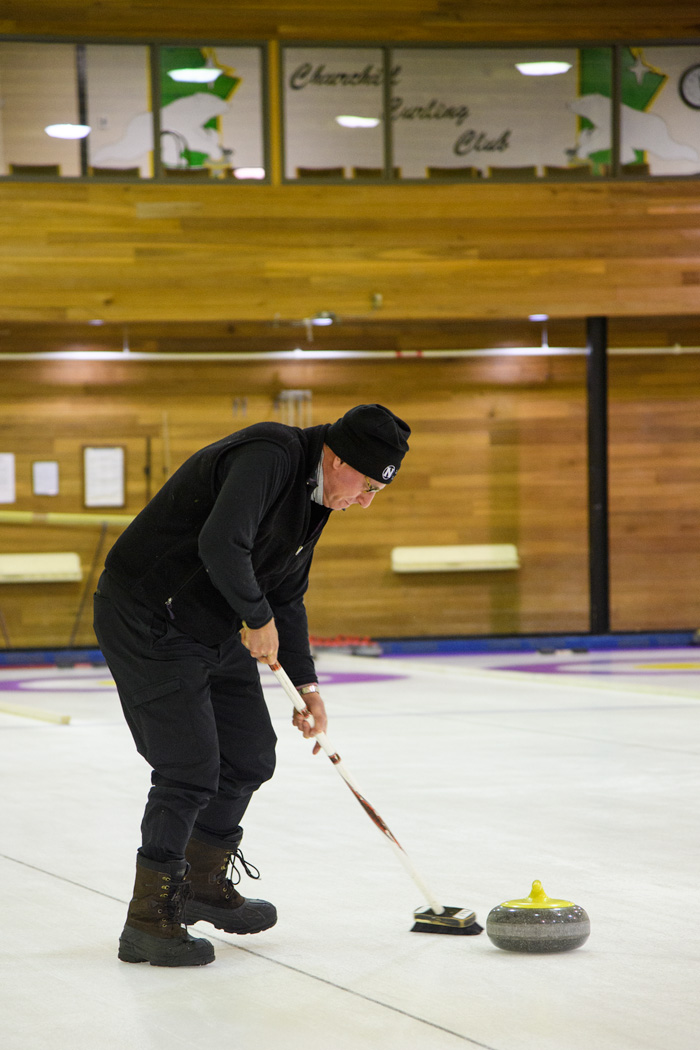Polar Bears of Churchill, Manitoba, Canada
There are only a few places in the world to see polar bears in the wild. This opportunity is further restricted by the fact that generally solitary polar bears have a huge territory range for most of the year and most live year round out on polar ice that is virtually inaccessible to human beings. The bears eat primarily seals, hauling them out of their breathing holes in the ice with their enormous paws. Some of the bears living furthest south, such as the population near Churchill have to move to land for a few months when the ice melts each summer. One place where polar bears can be seen is in Churchill Manitoba in the Wapusk National Park in Manitoba, Canada. The park area was created on the shores of Hudson Bay, where polar bears wait for the ice in Hudson Bay to freeze each fall. The bears don't eat during the summer, spreading out in Northern Canada or denning up to give birth to cubs, and are just waiting for the ice to form again, so they can go back out hunting.
A mother and her cubs wait for the ice to freeze on Hudson Bay to begin hunting seals.
With a helicopter (like the researchers use) or lots of time living in bear country, a human might have an encounter with a bear during the 8 months, or so of the year that the bears are on ice, but most chances for bear human encounters in Churchill will be in the late fall, mid October to mid November, when the bears start to literally lie on the shores waiting for the ice to from. Watching the bears on the shore waiting reminded me of this adaptation of a phrase about boiling water..."a watched bay never freezes!" But their month long wait on the shores of the Hudson Bay also provides a chance for human/bear encounters.
For most of human history, polar bear/human encounters consisted of bears being hunted by Inuit people who used every part of the bear for survival, or dangerous encounters where bears sought human food or sled dogs and had to be destroyed to protect people and property. We learned from our guides that governments who operate in polar bear range states joined together to make agreements which would allow traditional hunting for people who rely on polar bears for survival, but protect them commercial hunting, which was decimating the numbers of polar bears in the wild. Since then, efforts were made to ensure bear/human conflicts could be avoided. Polar bear tourism was developed to happen only in the safest ways for both humans and bears. During our trip we heard from Elizabeth Kruger, World Wildlife Federation Arctic and Bering Sea Program Officer, that local residents have been empowered and trained to use bear patrols to redirect bears from populated areas, and local activists have changed garbage handling methods to discourage them from seeking human food. Our polar rover driver described that growing up in Churchill, the family would go out to the dump to see bears. Today, creative handling and containment of garbage have eliminated the bears at the dump and they roam where they belong, in the tundra. In Canada concessions were given to allow operators to allow polar bear tourism in the safest possible way.
So...bears are being conserved, but there are only a few weeks a year in Churchill when it's practical to see polar bears, and the location to find them is still very remote...so how do you "go see it"?!
My tips for planning a Polar Bear Safari in Churchill
Here's what we've learned.
There is no "road to Churchill", so visitors will have to take a flight (click here) from Winnepeg, Manitoba or take the train (click here) over a couple of days to get into Churchill. Once in Churchill, you'll need to find a hotel or guest house. The polar bear season is the top tourism season in Churchill and there are only a few hotels or guest houses available in a very small outpost town and they will book up quickly, so advance reservations are critical.
Turbo prop planes or a two day trip on the railroad are the only way into Churchill.
Once you've arrived and got a room booked, you'll need to arrange a tour out onto the tundra with one of the concessionaires allowed to operate in the Wapusk National Park, there are dozens of guide companies, but all of them will use the same two companies who operate special tundra rovers purpose built to bring guests safely into the polar bear areas while also protecting the bears from becoming habituated to humans.
Special Polar Rovers or Tundra Buggies are purpose built observation vehicles that are allowed to follow several trails in the Wapusk National Park where bears gather for several weeks waiting for the Hudson Bay to freeze over. Guests would go out each day for excellent opportunities to see the tundra and boreal forest landscapes and wildlife!
Another option is to stay in a rolling train like lodge which is positioned on the tundra each polar bear season and allows guests to live in a fully self contained lodge (click here) out on the tundra.
With bunk houses, shared baths, dining and observation cars, the Tundra Lodge is like camping in a heated RV on the tundra. Visitors need to make a choice between the more private comforts of a town lodge, or the more wild experience of remaining enclosed in the lodge on the tundra day and night.
So if going it alone sounds complicated, there are several full service tour companies that offer packages that include transportation, lodging and daily activities to see bears and learn more about the culture and people of Churchill. We chose to travel with Natural Habitat Adventures (click here) They use some of the same outfitters you would use if you book your own trip, (and you might find, they've already booked most of the lodging for their guests) We were very happy with our Nat Hab trip because of their excellent guiding, partnership with the World Wildlife Federation, and the addition of unique opportunities to learn more about the culture and people of the north. But we mostly chose Nat Hab because they handle all the details of the trip for their guests, in an environment where "smooth" isn't even used to describe the ice on Hudson Bay! Between the weather, food arriving only occasionally by train and a busy, short tourist season in a village with only a few services like restaurants and hotels, it was nice to have someone else handling all the details. The weather alone can cause itinerary changes almost hourly, and our Natural Habitat Guide, Katie, handled them all with her cell phone and a smile, and communicated them well to our group, while we relaxed and enjoyed the scenery!
With farm more seats than people, and all the details handled by our Natural Habitat Guide Katie, our polar bear adventure was worth every penny!
Although it was a "group tour"; and nature people generally avoid "groups"; our group of 16 had our own polar rover, which could have easily held twice our group, so everyone had their own window seat and a seat next to them for gear. Had we gone alone, we would have shared the rover with a much larger group vying for space on the outdoor platform and at the windows. The food served was excellent, and I didn't realize how challenging that must have been until I toured the Northern department store in Churchill and saw that the whole produce section could have fit in my carry on bag! The prices were also shocking, making me appreciate how difficult it must be for local people to fill their fridges! It was a splurge to travel with Natural Habitat, as most safaris in remote areas are, but the testament to whether it's "worth it" was hearing from one couple in our group who was on their 5th trip to Churchill, and even though they were very familiar with the area and had planned their first couple of trips independently, they choose to return with Natural Habitat for last few because they felt the experience offered was worth the expense.
(As far as budget planning- when planning all inclusive guided safaris in the wilderness just about anywhere in the world, I have found I need to budget $500- $1000 per person per day. I will often compromise on the length of a nature trip rather than miss a peak wildlife experience by going at a cheaper time and missing the natural phenomena I came to see!)
Our Churchill Adventure Trip Report
Of course, our first flight was canceled...we didn't even leave Boston before our plans were derailed! (see our blog post about our challenges getting to Canada from Boston (click here)
Luckily, we were supplied with contact numbers from both our travel agent Expeditions Trips (click here) and the Natural Habitat Adventures in Winnipeg. We called both to let them know our new arrival time- unfortunately 12:30 AM, meaning we'd miss our briefing dinner, but would be likely to make our Sunday AM charter with our group. The Expeditions Trips agent called as soon as the day started on the west coast where they were located, and we spoke to a super helpful representative at Nat Hab in Winnipeg, who assured us we would be picked up at the airport even with our late arrival and told us all of the details we need to know. The driver was there as promised, our guide, Katie, left us all the briefing information we needed for the next day, and vouchers for the dinner we missed (which we couldn't use but appreciated!) An example of how seamless and proactive Nat Hab was, was that our driver made a point of explaining that on our charter flight the next morning, we should take note of the changes in the ecosystems as we flew north; from the plains agricultural regions, to lakes region, to the boeral forest and icy tundra. While we had read about this in the pre departure materials, had the shuttle driver not made a point to share that with us, we might have flown north and not thought to notice this phenomenon from the plane windows, and it turned out to be one of the many amazing experiences we had during our trip!
Photos from the window of our charter from Winnipeg to Churchill
Arrival In Winnipeg
We checked into the Fort Garry Hotel in Winnipeg very late, fortunately, even though it was late, we had all the tags and notes we needed to get prepared for our adventures the next day.
Winnipeg from the air
The Lobby of the Ft Garry Hotel
A reproduction of an old postcard adorns the walls.
Day 1 Winnipeg to Churchill
We arrived in Churchill around lunchtime and our first stop was the Tundra Inn for lunch.
After lunch we checked into our lodge, the Seaport Hotel (click here) and met in the lobby to go out for our first excursion in the town of Churchill.
The Seaport Hotel is a modest but comfortable base for touring in Churchill.
Our first excursion was to the Parks Canada Visitor Reception Centre, where we had the privilege of meeting park ranger, Rhonda, who after taking a moment to remove her outer "non-issue" fleece, stepped into her official role as park ranger, where she regaled us with information about polar bears and stories about life living in in the north in polar bear country. The best stories were about the detention center for unruly juvenile polar bears, who like young drunk college students can sometimes act badly, and are kept a while till the ice freezes and then sent on their way out onto the frozen bay! We also saw many taxidermy specimens of other creatures we might see in the area. (All legally obtained by Parks Canada from wild life law enforcement seizures)
Rhonda shows our group a model of a polar bear den at the Visitors Centre, which she assured us was created with "woolen" bears.
A diorama of a polar bear den with the woolen bears!
After our stop at the Visitors Center, we made our way by bus with our driver for the trip, Stephanie, to the Rover Launch area for Great White Bear, one of two outfitters permitted to run vehicles in the National Park.
Our bus driver, Stephanie, poses with the man who invented and perfected the comfortable polar rover we used while out on safari on the tundra.
We enjoyed some wildlife spotting from the bus on the way to the launch and on the tundra as the sun set.
We were introduced to our Rover driver for the duration of our visit to Churchill, Stu, a retired RCMP and current polar river driver for Great White Bear. Stu, not only shared insight into life in Churchill, having grown up there, but was also very knowledgeable about the animals we saw and helping guests to spot them in the distance. When the rover was stopped for meals or snacks, he quickly transitioned to waiter extraordinaire, serving amazingly gourmet meals from coolers in the rear of the rover. We were also pleasantly surprised by the level natural Habitat went to accommodate special diets. There were few vegetarians and others with religious diet restrictions, which were accommodated cheerfully and unobtrusively. I had heard the rovers described as school buses on big wheels, but they are much more than that! The heated extra wide vehicle with a marine style toilet in the rear, comfortable coach bus style seating, a large mesh grate floor viewing platform in the back, made for a very comfortable day in the rover!
Our GWB driver, Stu, managed the rough E-ticket terrain of the tundra safely!
The Launch Area is set up with a high platform so guests can get into the rover without needing to climb up stairs, directly from the transfer bus, guests are not allowed to wander in this area and a spotter, armed with bear deterrents, kept watch during the transfers.
Comfortable and roomy, the polar rover also became a rolling tundra cocktail party at dark.
All of us were anxious to see bears, but we weren't spotting any on our first evening out. We did see the most incredible sunset on the tundra, and even though we were all a little disappointed, we couldn't help but feel privileged and awed by the environment! We put our cameras away and enjoyed dinner set out in the rover on the dark tundra. Then just as we were getting ready to leave, someone spotted a mother bear and two very young cubs outside of the rover, walking right in front and beside the vehicle. Too dark to photograph, we could see their white fur glowing from the dim interior lights of our polar rover and just enjoyed the magical moment of seeing polar bears in the wild for the first time!
Day 2 Halloween in Churchill Exploring on the Tundra
Sunrise on the tundra
We had an early start on Halloween morning, heading out at 8 AM in the dark (days are short this close to the poles in October and November) and after embarking the Polar Rover, we enjoyed coffee and the beautiful sunrise over the tundra. We were joined today with a special guest, Elizabeth Kruger, World Wildlife Federation Arctic and Bering Sea Program Officer, who shared information about polar bear conservation efforts. (Natural Habitat Adventures has a partnership with WWF, and every guest becomes a member of WWF as part of the cost of their trip)
Our Guide Katie, and WWF Program Officer, Elizabeth shared their knowledge and their silly Halloween costumes!
At about 9:30 AM we spotted our first wildlife siting. A large male plodding along the coastline. Just ahead of him, we spotted a mother and 2 cubs hustling away, trying to put some distance between them and the big male. Our guides told us males will try to separate mothers and cubs in order to mate with the female and young cubs, under 2 years, cannot probably not survive on their own. The female bear headed up towards several rovers which were parked watching the bears on the shore.
A female moves her cubs quickly along the shore to avoid a large male behind her.
After passing by several polar rovers filled with delighted guests, she settled into some willows to nurse her cubs.
Female bear nursing her cubs
Another exciting bear sighting came around lunchtime. A female bear was sleeping very close to the polar rover tracks and we were able to park and watch her stretch and nap.
After this big bear put her head down, our guides called us in to have lunch on the polar rover. After lunch the bear got curious about the smell of food and decided to explore where it was coming from, thrilling all of us on our rover, by walking right under the mesh platform of the viewing platform and exploring the rover on her hind legs.
A big yawn...
...testing out what she was smelling... our guides and the Parks Canada ranger described her ear tags, explaining that using collars is controversial, and ear tags in red or green colors, though easier to spot from a distance are more likely to be removed by the bears, where the white ones seem to go unnoticed.
getting up on her massive paws to investigate.
The bear walked right under the platform on the rover.
Bored with us, even though we could have watched her all day, the bear, moved on
We moved on until around 1:30 PM, a large male started headed toward us. We parked hoping it would keep moving in the same direction.
A large male bear on the move, walked right by our rover.
Just for fun, I set my video to time lapse and captured the big male moving towards us a faster clip than he usually moves!
To give you an idea...this is the bears usual pace, our guides explained that it's optimized to keep them from overheating and conserve their energy, since they go months without eating until the ice forms and they start hunting seals again.
This bear investigated a neighboring rover.
Reluctantly, it was time for us to start our journey back to the launch. The guides and drivers keep the schedule, even though we could have could stayed out on the tundra forever after the exciting bear sightings we had on Halloween! The trip back was not disappointing, enjoying the beautiful scenery, E ticket rover ride through lakes and over rocks, and we even spotted some more wildlife!
A raven picks through kelp looking for food.
A silver fox- distinguished by the white tip on it's tail (not visible here) can be a variety of colors. They are easier to spot because they move so quickly and often their color contrasts with the environment.
On the way out of the Great White Bear polar rover launch area, our group posed with a rover near the entrance, while our bus driver carefully watched for bears!
In the evening, we enjoyed dinner and a short talk with Elizabeth about her work in polar bear conservation for World Wildlife Federation.
Day 3 November First Another Day Exploring the Tundra!
We were up and out early for our second full day out on the tundra looking for bears. We enjoyed another glorious sunrise, while we headed out along the tracks in the permafrost in the polar rover. Our driver, Stu, made changes in the itinerary to make sure we would have the opportunity to spot polar bears and sure enough, it wasn't long before we spotted a trio resting by the bay quite a long way off. I will advise that having good binoculars goes a long way in spotting the bears, and enjoying them once spotted. We were lucky to have several close up experiences, but there are no guarantees.
This trip with its focus on bear conservation, demands that we observe but not disturb, so sometimes the bears are at a long distance, and we must watch them from where we are. Of course, the bears have no such rules, and frequently, these smart, curious animals would see the rovers and want to do a little exploring themselves. That's what happened in this case. A mother bear and what we later discovered was two female cubs were sleeping, but once we stopped about 1/2 mile away, one of the young cubs was curious and started making her way towards our rover and the others parked near us. She looked back at her more timid sister and slumbering mother, and seemed to be urging them to come explore with her. She started out and before long, her sister followed along behind. After they got a certain distance away, mamma bear heaved herslef up and plodded along behind her curious off spring.
It wasn't long before the family of three was very near our rovers, curiously sniffing and then parading down along the road past all of the awestruck visitors on the rovers.
Mama Bear follows her curious cubs across the tundra towards our rover.
Mama bear and the girls give the rovers filled with tourists a good sniff.
The sisters stick close by each other as they explore the rovers
The family of bears walked the whole line of rovers prompting us to ask our driver and guide just how much they had paid the bears for the encounter! After a few minutes of curious sniffing the bears moved on providing us with incredible photo opportunities!
After using all the energy to explore, the cubs rested on the ice.
The brave cub cooling down on the ice after their long walk!
Mamma bear led the way, sniffing the way ahead for safety and waiting patiently for her cubs to follow despite their wanting to "do their own thing"
Finally, her cubs hustled up and they padded off together across the frozen pond!
After the excitement of watching this bear family, we enjoyed a catered lunch on the polar rover and shared our experiences and photos. We also didn't stop looking for animals, barely seeing this one!
Can you spot the animal? A ptarmigan is barely visible in the snow!
Easier to spot were the silver foxes, we saw a variety in lots of colors, black, red, grey, but all distinguished as silver foxes by their white tipped tails!
After a little while, someone spotted another group of sleeping bears. This time a very sleepy mother bear
Looking quite a lot like the rocks studding the lake shore, a mother bear and her two cubs of the year rested soundly on a little peninsula of willows.
We watched the sleepy family for a little while and then noticed a large male making his way towards their direction. To hear more about the "Polar Bear Mama Drama" see our post here.
A big male on the move...
He gets a sniff of the female bear and her cubs and starts to change his course to head towards her and the young cubs
Our guides explained that a male can try to separate the mother from her cubs in order to mate with her. The cubs will surely not survive on their own without their mother, and their survival depends on her staying away from the big male. Unfortunately, she and the cubs were sleeping soundly as the male approached closer and closer, and all of us held our breath in dread of what we might see if he surprised them before they could hustle away.
Finally, as we all silently willed the mother bear to wake up and move on, she was up on her feet and she and her cubs were on the move even faster than Jeff's rapid camera could catch it!
So once she started to move, she and her cubs MOVED! Some in our group actually were able to hear her hiss at the big male. They ran towards our rover at top speed until she was right behind our viewing platform
Directly behind us, the female stopped to see where the big male was, and found him to be plodding along in her direction, so although she slowed her speed, she and her cubs continued moving off away from the larger bear.
Directly behind our rover, the female took a minute to sniff the air and check for the big male.
The mother and her young cubs moved off towards the shore.
The big male moved more slowly but quite deliberately in her direction, stopping along the way to sniff where she and the cubs had been.
Finally, not wanting to expend much energy, the large male stopped in a stand of willows near our rover to rest, leaving the female and her cubs safe to wander away.
Tired of the chase, the big male rests in the willows.
The big male bear also passed right behind us with a great view from our viewing platform.
After two exciting bear sightings, we started heading back to the "launch" where we started. All along the way, we continued to seek out wildlife.
There isn't much terrain, these rovers can't manage, including these deep icy puddles.
We spotted some more sleepy "polar bear rocks" and another silver fox- this one gray and black and easy to spot in the snow, and some more well camouflaged ptarmigan.
Once we returned to the town of Churchill, we planned to gather for dinner and an evening of poetry and perspective about life in Churchill from Koral Carpenter
Koral, guide and poet, shared her perspective as a person who was drawn to the arctic and the bears, which was a common theme among people who work in Churchill during the polar bear season!
Day 4 A day to learn a little more about Churchill
At the ranger station at Cape Merry, I learned first hand why parka hoods are so large, and why they have fur around the rim!
We awoke on our last day in Churchill to find a big change in the weather. We did not have another day on the tundra to see the bears, our itinerary was to learn more about Churchill, and travel back to Winnipeg. We recognized we had been lucky with the visibility to see bears over the last 3 days, as the storm blew in, it would be very challenging to spot polar bears in this environment! Our guide, Katie, logistical goddess, was on the phone. The charter air company was moving our flight up by one hour to take off before the worst of the storm hit. As usual, Natural Habitat was on top of changes to make them as seamless as possible. A scheduled lunch at Gypsy's (whose incredibly tasty pastries we had enjoyed for several days!) was nixed for a boxed lunch from Gypsy's to eat at the airport. Our itinerary was adjusted to get us out to Cape Merry early, to "experience" the weather- there was no "seeing" the bay from this lookout, in this weather, with visibility getting worse by the minute!
Cape Merry is at the mouth of the Churchill River and the Hudson Bay, and on our trip out there we passed by the grain factory, where grain was brought by rail from central Canada, processed and then placed on ships in the port to head out onto the Hudson Bay to customers beyond. Unfortunately, about a year ago, when the port closed, the factory also closed, and we were told, the effect on the community has been devastating.
The grain factory, which had been a major employer is now closed.
A view out to the bay from Cape Merry
Our group bundled up and were met by two Parks Canada rangers, one who watched our backs while holding a firearm to scare off wandering polar bears, and one who took us out to the "lookout" to see what we could see. What we could see was pretty much nothing! It was quite incredible to imagine that many Inuit people make their lives in weather like this, most of our group lasted about 5 minutes, just long enough for a selfie, outside of our comfy bus!
After experiencing just a taste of what Churchill might have to offer in the winter, our group made it's way to what was known as the Eskimo Museum. The museum is in the process of renaming itself, Itsanitaq Museum, which translates to mean "things from the past". We learned that the native people in the Arctic don't all agree on terms for themselves, nor are they monolithic. In Churchill, Inuit is generally accepted, but the new museum puts the emphasis on the artifacts in the museum rather than the names of the groups of people who created them!
The curator of the museum shares the new name and graphic for the museum of things from the past in Churchill.
After spending an hour or so visiting the museum, which was filled with useful objects that were important to the lives of people living in a traditional way, but also incredible works of art created by native artists.
Our next stop was a visit to the Town Center Complex. After experience just a taste of the weather in Churchill, adding in the constant threat of the worlds largest land predator, and the dark arctic winters, we visitors could see how this mutli million dollar complex would be the cnter of civic life. With a school, library, town and postal offices, as well as a multitude of recreational venues, including a teen center, movie theater, playground, ice and curling rinks.
A polar bear slide at the Town Center Complex
Our driver Stephanie is a member of the Churchill Curling Club, and we were fortunate to have her share her love of the sport and let us give it a try! Let's just say that it is one of those sports that looks much easier than it is!
Our driver Stephanie shows the proper form, harder than it looks!
After having a few good laughs and escaping the worst of the weather for a couple of hours, we made our way to the airport for our charter flight back to Winnipeg. We watched the town of Churchill and the tundra fall away, and many of us were already thinking about when we could return!
A piece of art work at the Itsanitaq Museum.












